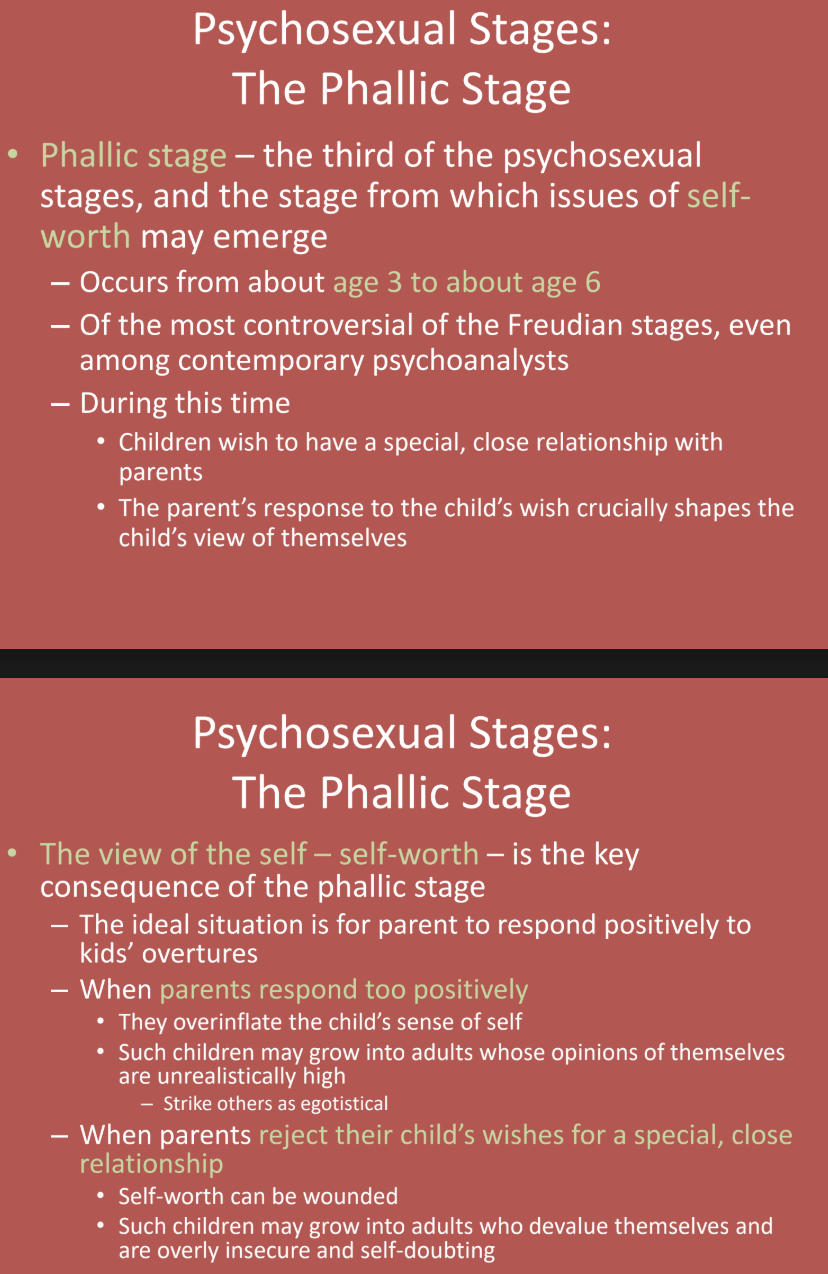Lecture 13: Psychodynamic Psychotherapy
1/83
Earn XP
Description and Tags
By Jordana Burstein for Clinical Psychology
Name | Mastery | Learn | Test | Matching | Spaced |
|---|
No study sessions yet.
84 Terms
Why do we begin with the psychodynamic approach? (Psychodynamic Psychotherapy)
We begin with the psychodynamic approach because it came first historically, and for much of the first half of the 1900s, it was practically synonymous with psychotherapy itself.
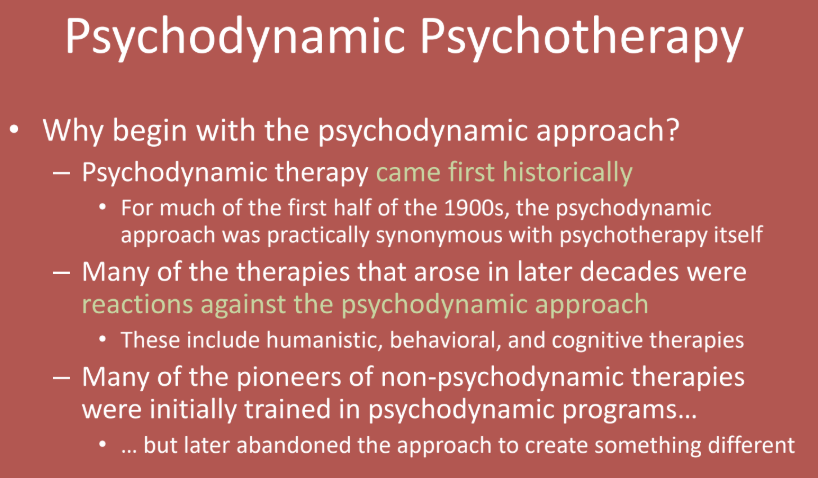
What type of therapy came first? (Psychodynamic Psychotherapy)
Psychodynamic therapy came first, historically.
For much of the first half of the 1900s, the psychodynamic approach was practically synonymous with psychotherapy itself
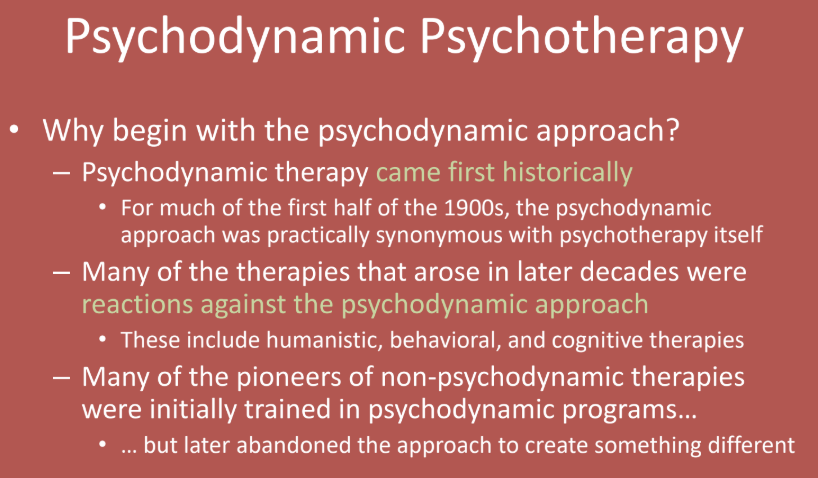
How were later therapies a reaction against the psychodynamic approach? (Psychodynamic Psychotherapy)
Many therapies that arose later, such as humanistic, behavioral, and cognitive therapies, were reactions against the psychodynamic approach.
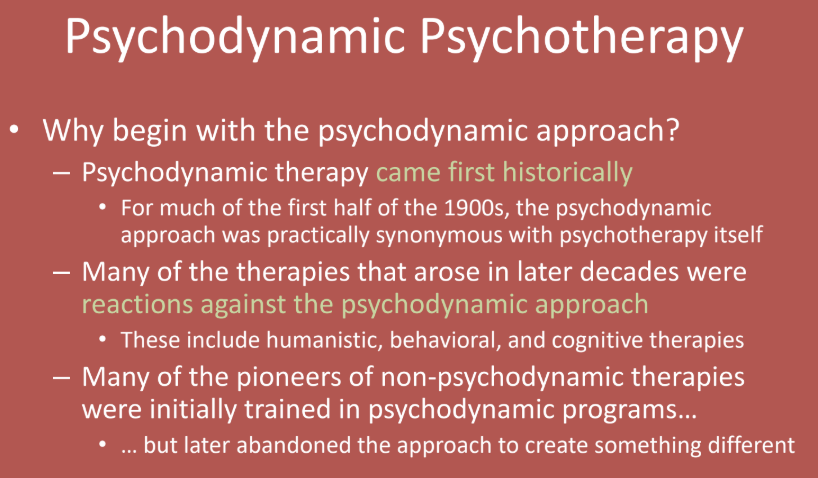
What did many non-psychodynamic therapists start as? (Psychodynamic Psychotherapy)
Many non-psychodynamic therapists started as psychodynamic practitioners but later abandoned the approach to create something different.

How has the reputation of psychodynamic therapy changed? (Psychodynamic Psychotherapy)
The reputation of psychodynamic therapy has declined. It is often criticized as being outdated, with concepts considered too vague to be rigorously studied, and it is viewed as being less popular compared to therapies like cognitive-behavioral therapy.
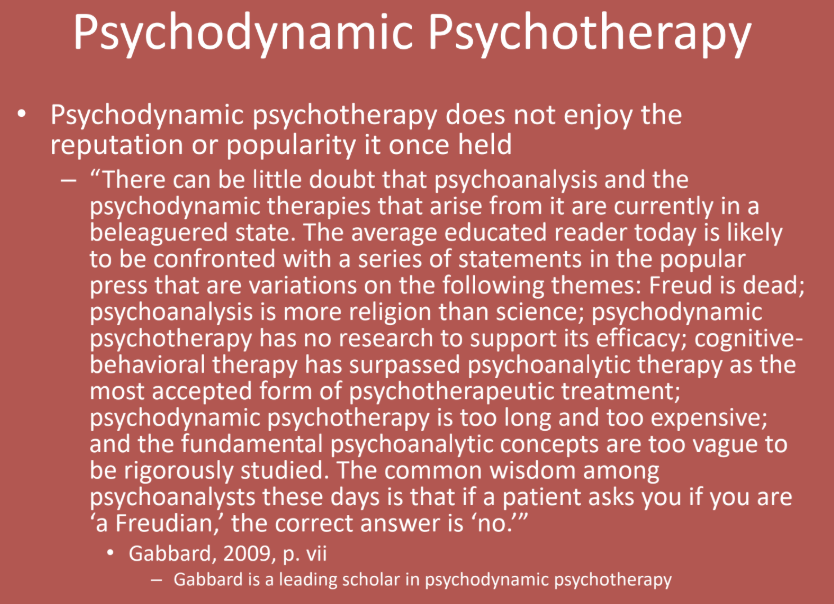
Does psychodynamic therapy still remain relevant? (Psychodynamic Psychotherapy)
Despite its decline, psychodynamic therapy remains relevant and is widely used, influencing contemporary clinical psychology through adaptations of its traditional methods into novel approaches that suit modern culture.
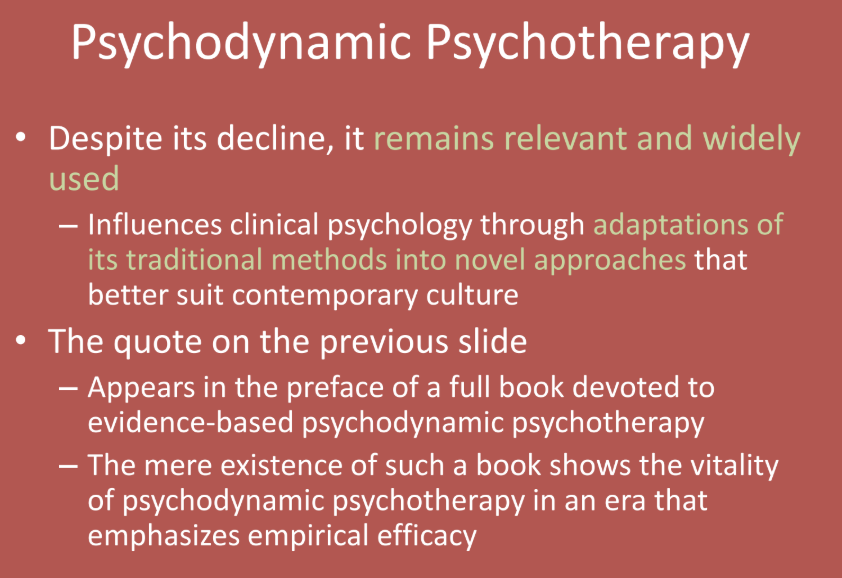
How has psychodynamic therapy been adapted? (Psychodynamic Psychotherapy)
Psychodynamic therapy has been adapted through evidence-based psychodynamic psychotherapy and other methods that incorporate traditional approaches while better fitting contemporary cultural and clinical needs.
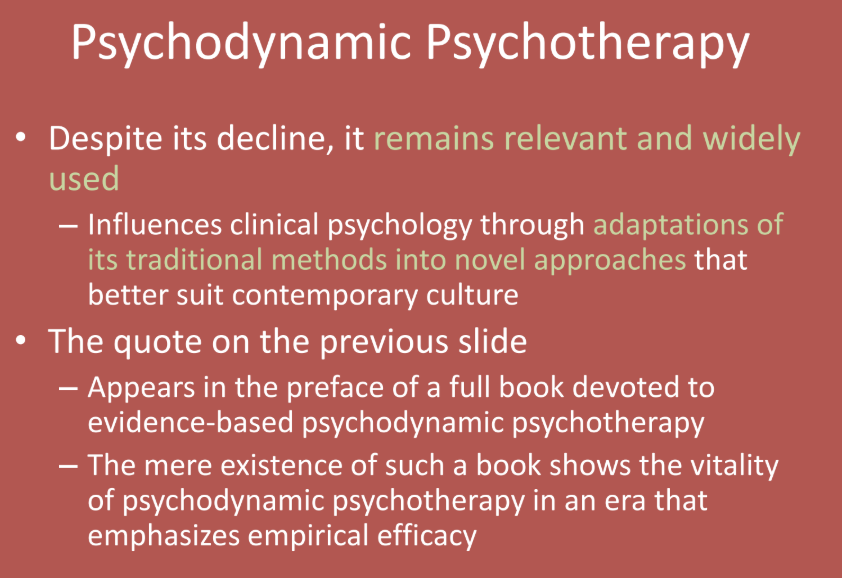
Who is Sigmund Freud? (Psychodynamic Psychotherapy)
Sigmund Freud is the pioneer of the psychodynamic approach to clinical psychology, and the creator of psychoanalysis.
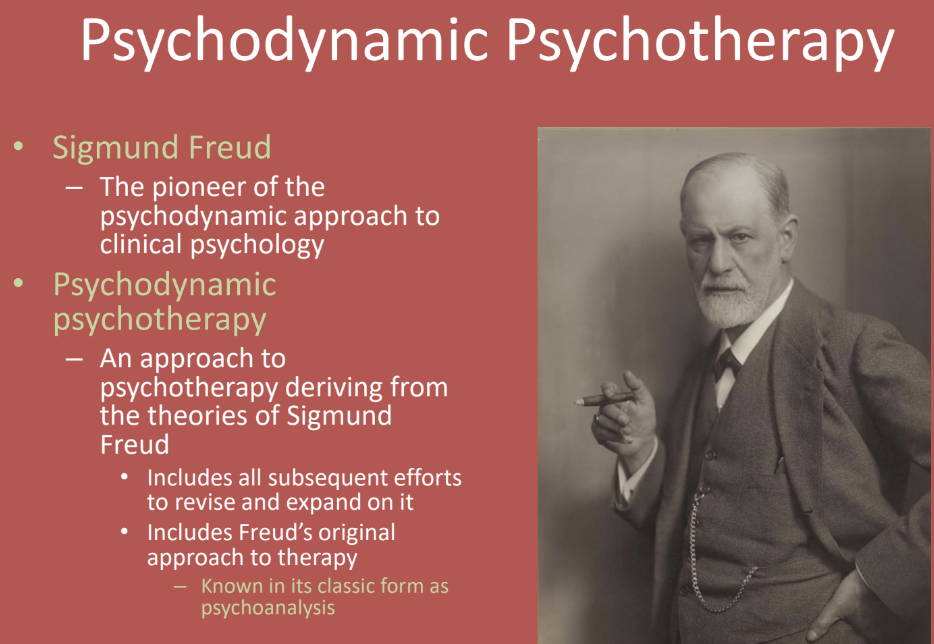
What is psychodynamic psychotherapy? (Psychodynamic Psychotherapy)
Psychodynamic psychotherapy is an approach to psychotherapy that derives from the theories of Sigmund Freud, including all subsequent revisions and expansions on his original approach.

What is the classic form of psychodynamic psychotherapy? (Psychodynamic Psychotherapy)
The classic form of psychodynamic psychotherapy is psychoanalysis, the original approach developed by Freud.
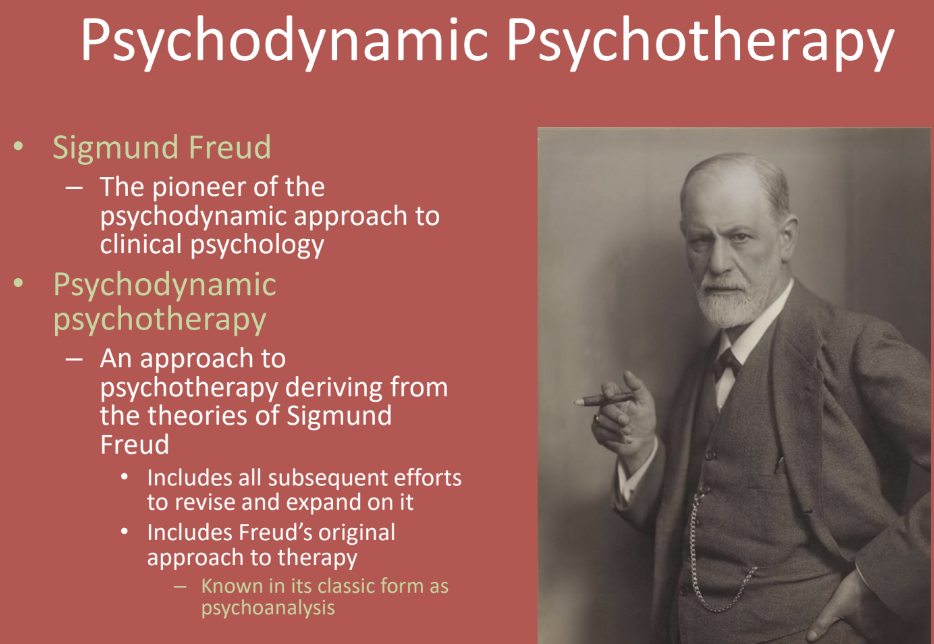
What was Freud's original term for his therapy, and what was it replaced by? (Psychodynamic Psychotherapy)
Freud's original term for his therapy was psychoanalysis, but it was later replaced by terms such as psychoanalytic psychotherapy, neo-Freudian therapy, and ultimately psychodynamic psychotherapy.

What is the primary goal of psychodynamic psychotherapy? (Goal of Psychodynamic Psychotherapy)
The primary goal of psychodynamic psychotherapy is to make the unconscious conscious, helping clients become aware of thoughts, feelings, and mental activities they were previously unaware of.

What is insight in psychodynamic psychotherapy? (Goal of Psychodynamic Psychotherapy)
Insight is the process of looking inside oneself and noticing something that had previously gone unseen, often related to unconscious thoughts and feelings.
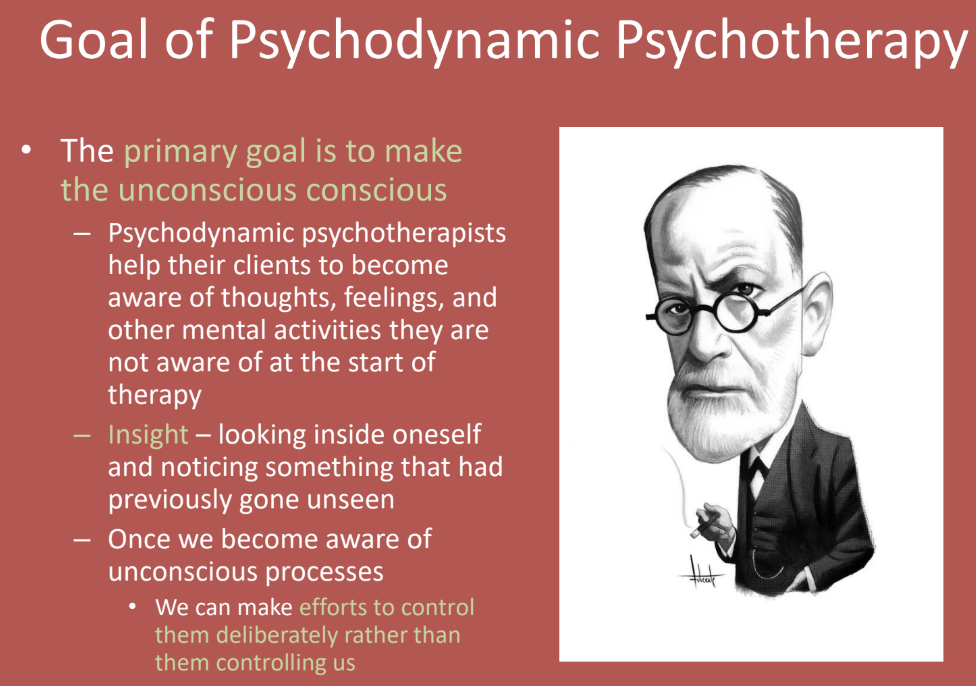
What can we do once we make the unconscious conscious? (Goal of Psychodynamic Psychotherapy)
Once we become aware of unconscious processes, we can make efforts to control them deliberately, rather than allowing them to control us.
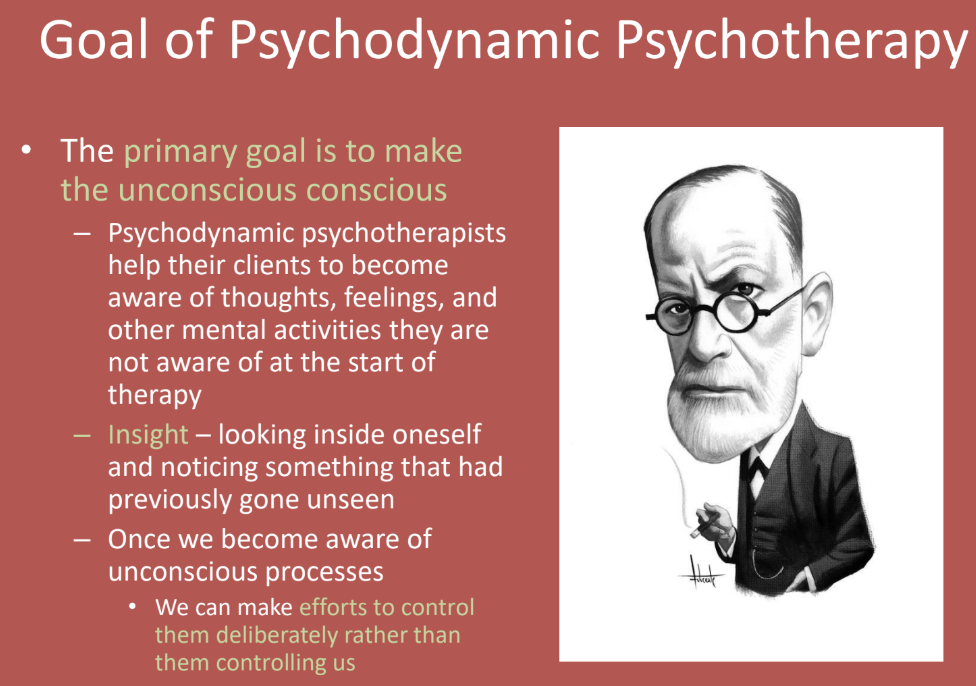
What is the unconscious? (The Unconscious)
The unconscious is mental activity occurring outside our awareness, influencing our thoughts, feelings, and behaviors without us being consciously aware of it.
One of Freud’s most important and enduring contributions to clinical psychology
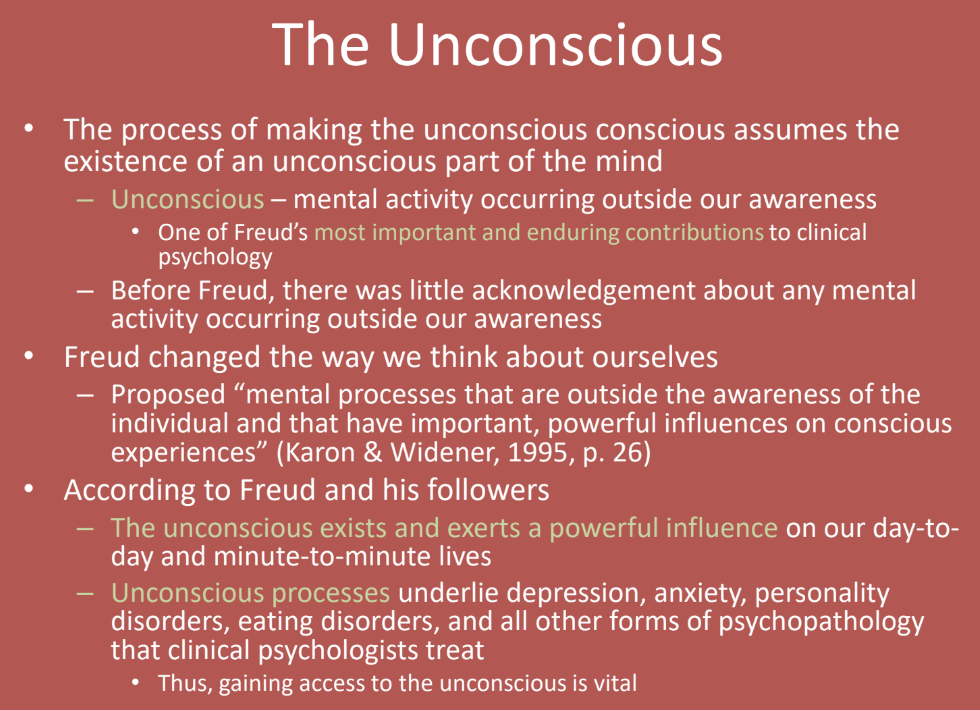
What did Freud say about the unconscious? (The Unconscious)
Freud proposed that the unconscious exists and exerts a powerful influence on our daily lives, affecting our emotions, thoughts, and behaviors. He believed that unconscious processes underlie mental health issues like depression, anxiety, and personality disorders.
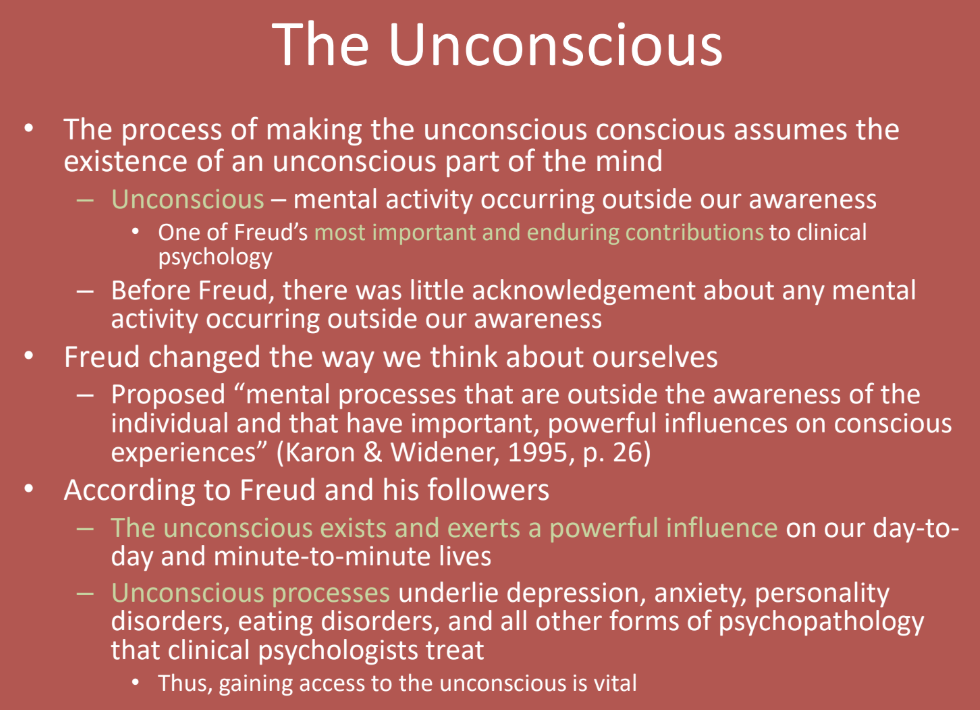
How do psychodynamic psychotherapists NOT access the unconscious? (Accessing the Unconscious)
This is not done in an empirical and/or factual way
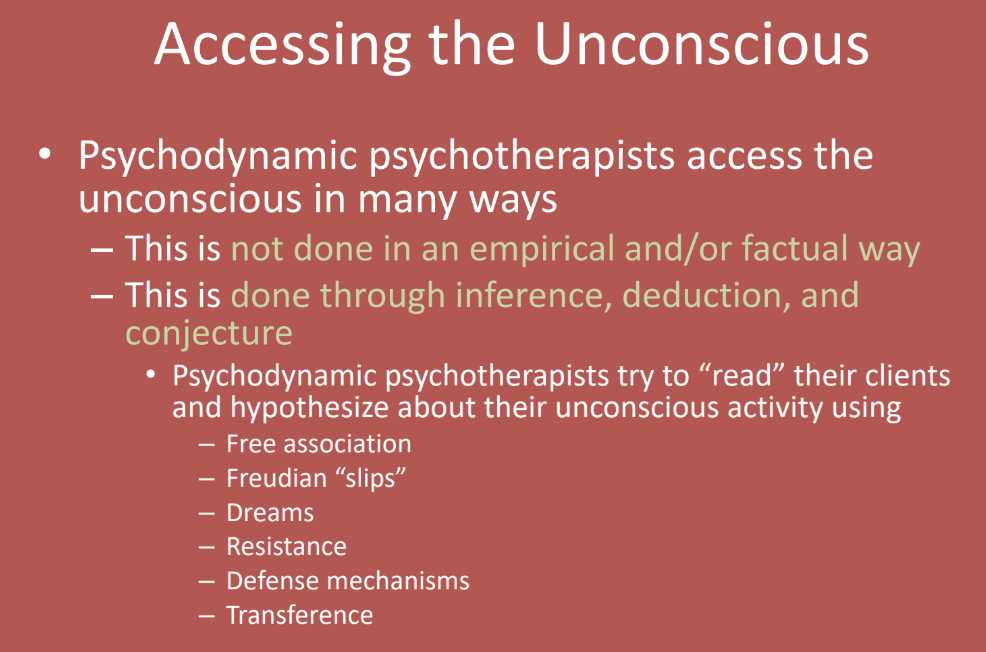
How DO psychodynamic psychotherapists access the unconscious? (Accessing the Unconscious)
This is done through inference, deduction, and conjecture
Psychodynamic psychotherapists try to “read” their clients and hypothesize about their unconscious activity using
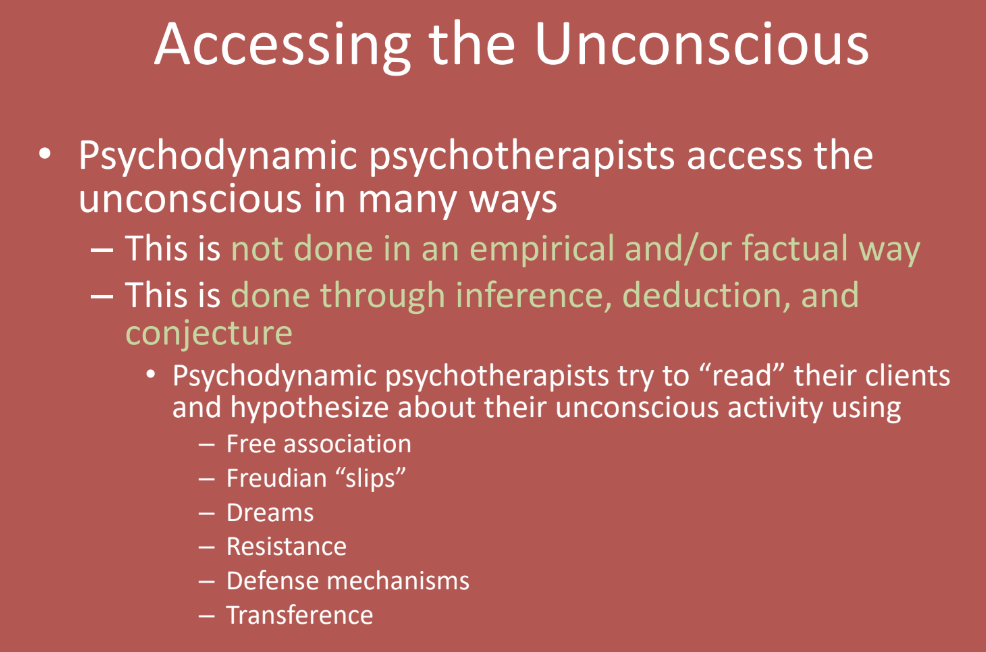
What methods do psychodynamic psychotherapists use to read their clients? (Accessing the Unconscious)
Psychodynamic psychotherapists access the unconscious through methods like free association, Freudian slips, dreams, resistance, defense mechanisms, and transference, using these clues to hypothesize about unconscious activity.

What do psychodynamic psychotherapists try to do for their clients by using these methods? (Accessing the Unconscious)
Psychodynamic psychotherapists aim to help clients gain awareness of their unconscious processes, which can lead to better control over those processes and improved mental health.

What is free association? (Free Association)
Free association is a technique where clients are asked to say whatever comes to mind without censoring themselves, no matter how nonsensical, inappropriate, or illogical it may seem.
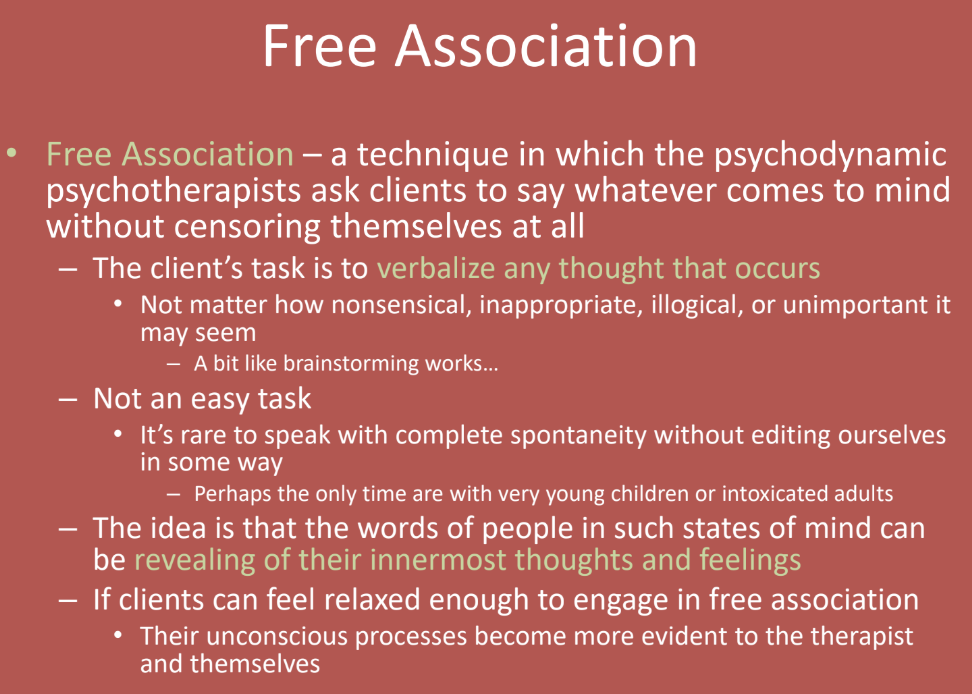
What is a client's task during free association? (Free Association)
The client's task during free association is to verbalize any thought that occurs, without editing or filtering it in any way.
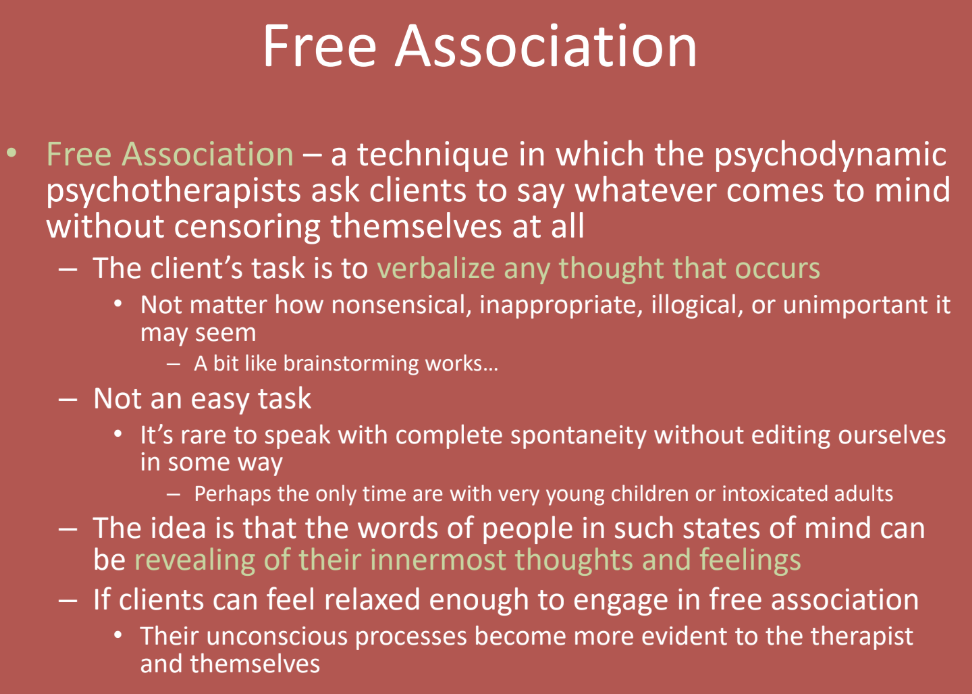
What is the idea behind what free association helps to reveal? (Free Association)
Free association helps to reveal unconscious processes, allowing the therapist and the client to uncover innermost thoughts and feelings that are typically hidden from conscious awareness.
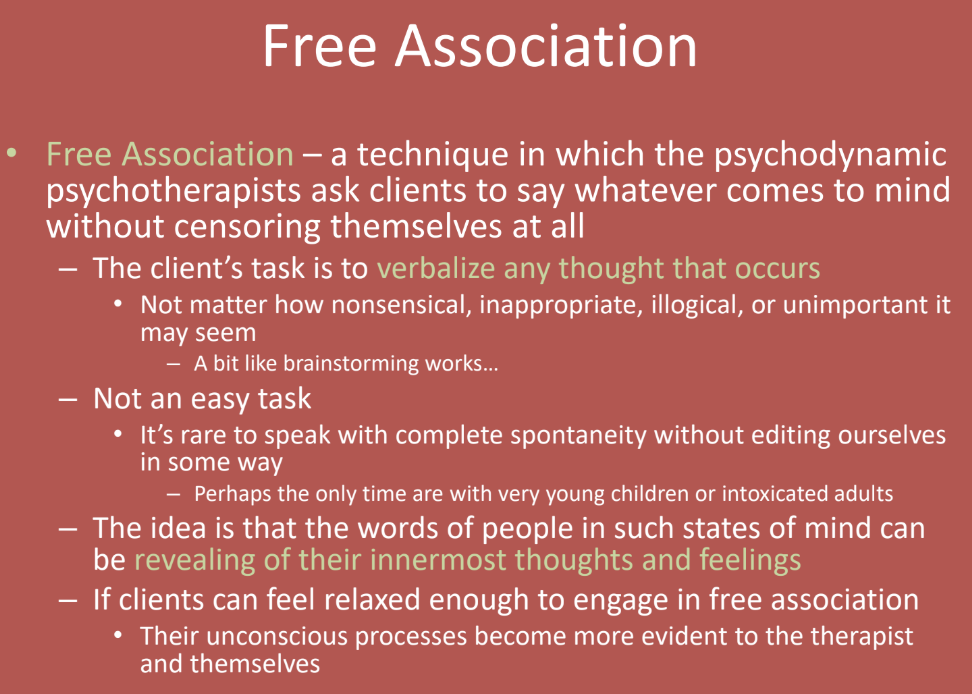
What is a Freudian slip? (Free Association)
A Freudian slip is a verbal or behavioral mistake that psychodynamic therapists believe is determined by unconscious motivations, revealing hidden thoughts or desires.
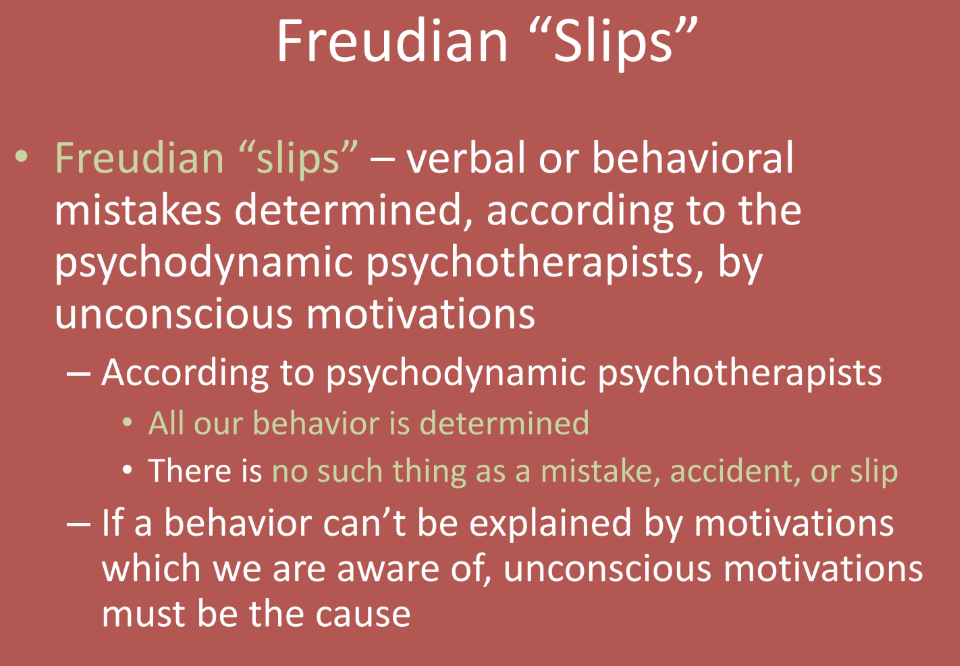
What do psychodynamic therapists say about behavior and mistakes? (Freudian “Slips”)
Psychodynamic therapists say that all behavior is determined and that there is no such thing as a mistake, accident, or slip. If a behavior cannot be explained by conscious motivations, unconscious motivations must be the cause.
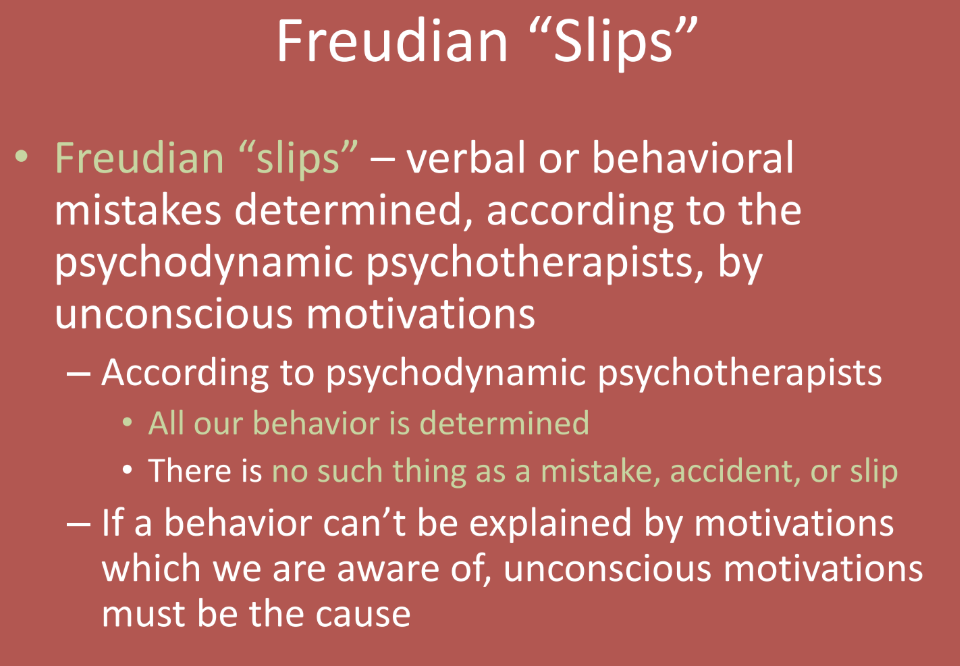
What do psychodynamic psychotherapists believe about dreams? (Dreams)
Psychodynamic psychotherapists believe that dreams communicate unconscious material, revealing hidden thoughts and feelings from the unconscious mind.
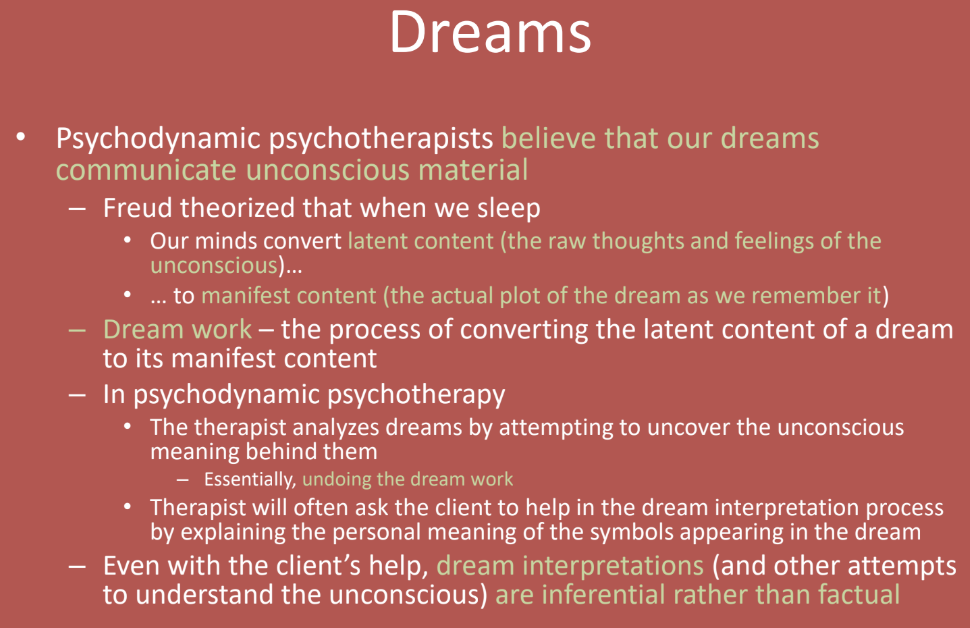
What did Freud theorize happens when we sleep? (Dreams)
Freud theorized that when we sleep, our minds convert latent content (unconscious thoughts and feelings) into manifest content (the actual plot of the dream) that we remember.
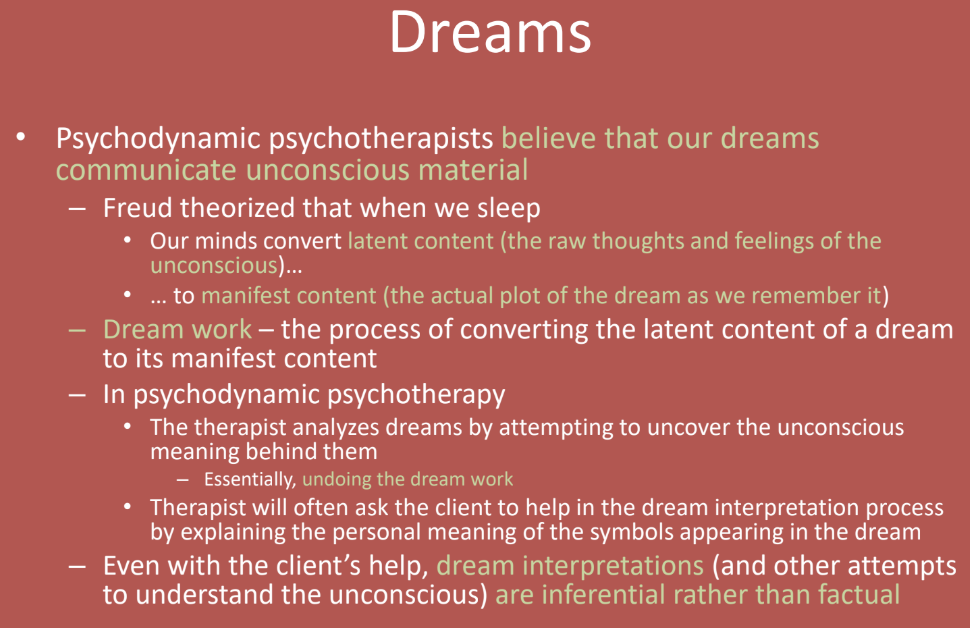
What is dream work? (Dreams)
Dream work is the process of converting latent content (unconscious thoughts and feelings) into manifest content (the dream's actual plot or images).
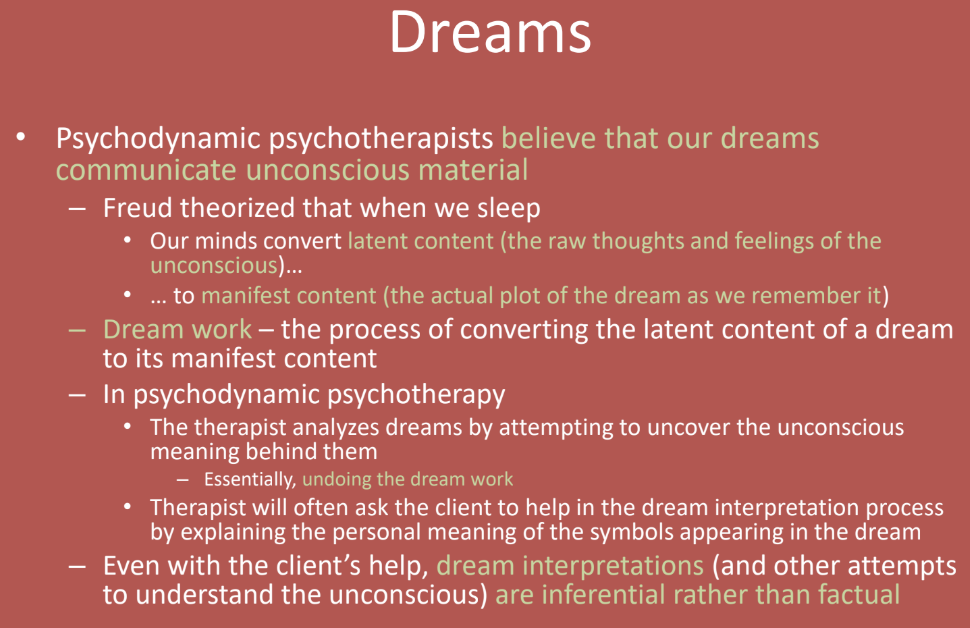
What does psychodynamic therapy do for dream work? (Dreams)
In psychodynamic therapy, the therapist analyzes dreams by attempting to uncover the unconscious meaning behind them, essentially undoing the dream work.
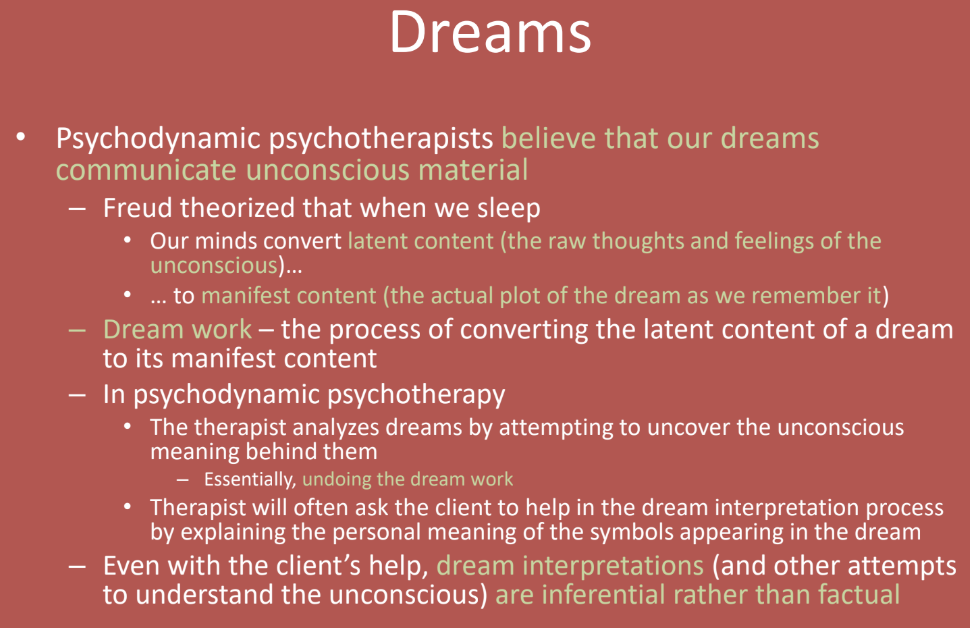
Are dream interpretations in psychodynamic therapy inferential or factual? (Dreams)
Dream interpretations in psychodynamic therapy are inferential, not factual, meaning they are based on hypotheses and educated guesses rather than objective facts.
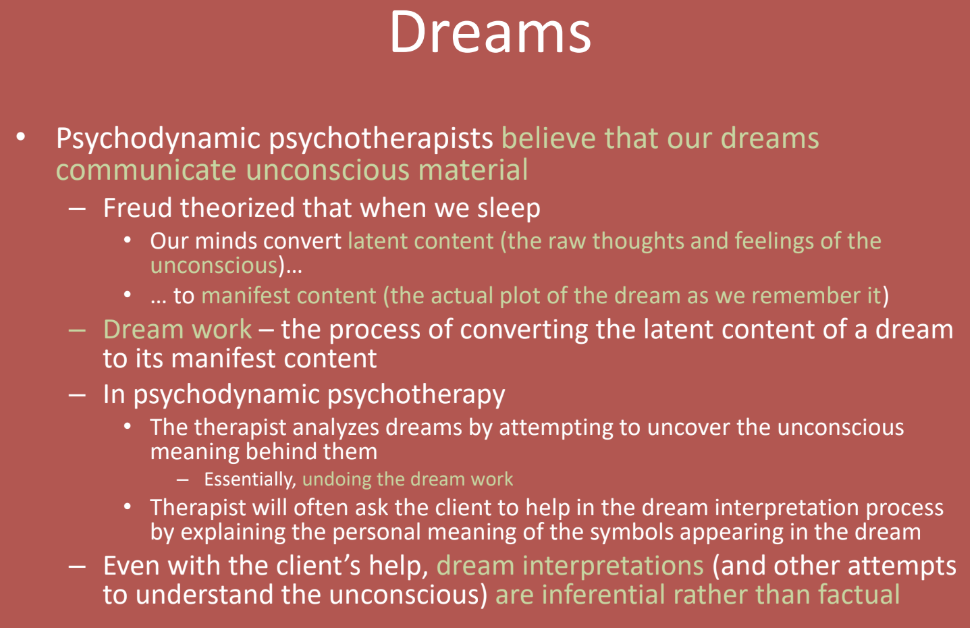
What is resistance in psychodynamic therapy? (Resistance)
Resistance is when clients exhibit behavior that impedes or delays the discussion or conscious awareness of certain topics or emotions, often due to anxiety or discomfort.
According to psychodynamic psychotherapists, clients feel anxious when thoughts and feelings are being laid bare too extensively or too quickly
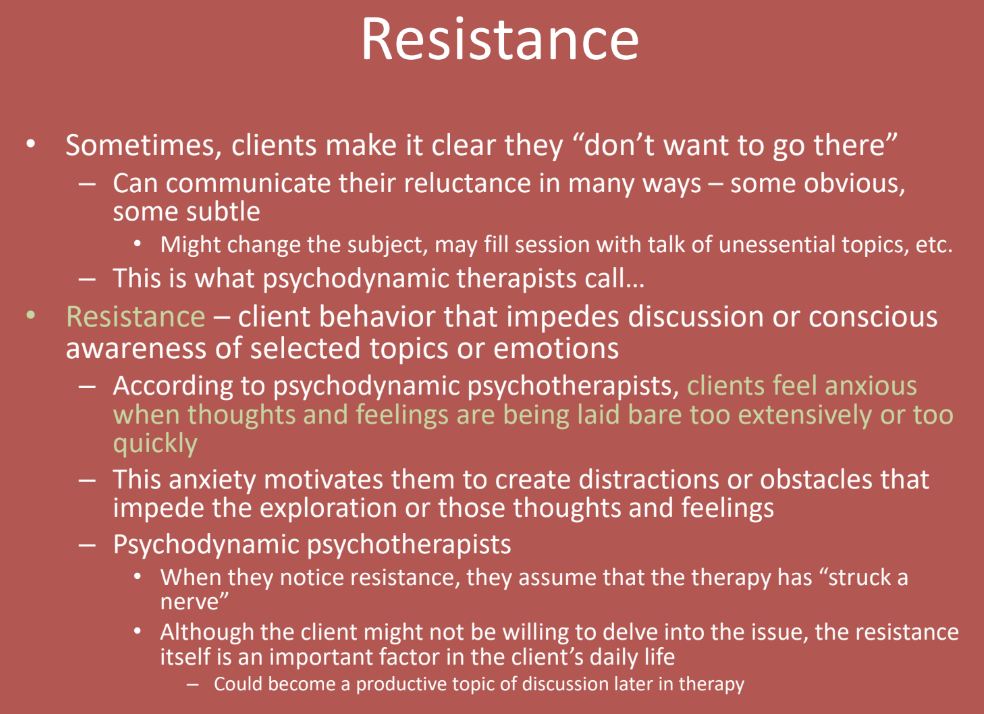
What do psychodynamic psychotherapists say about resistance in clients? (Resistance)
Psychodynamic psychotherapists view resistance as a sign that therapy has struck a nerve and may be an important topic for future exploration, even if the client is unwilling to delve into the issue immediately.
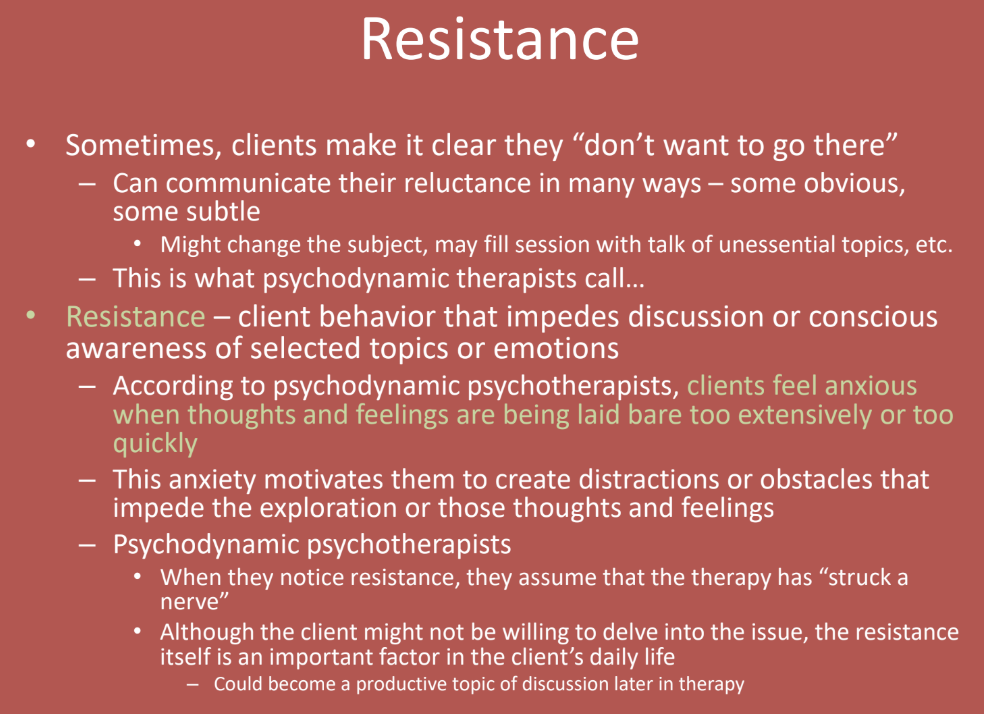
What are defense mechanisms? (Defense Mechanisms)
Defense mechanisms are unconscious psychological strategies used by the mind to protect itself from anxiety, conflict, or unpleasant emotions by distorting reality.
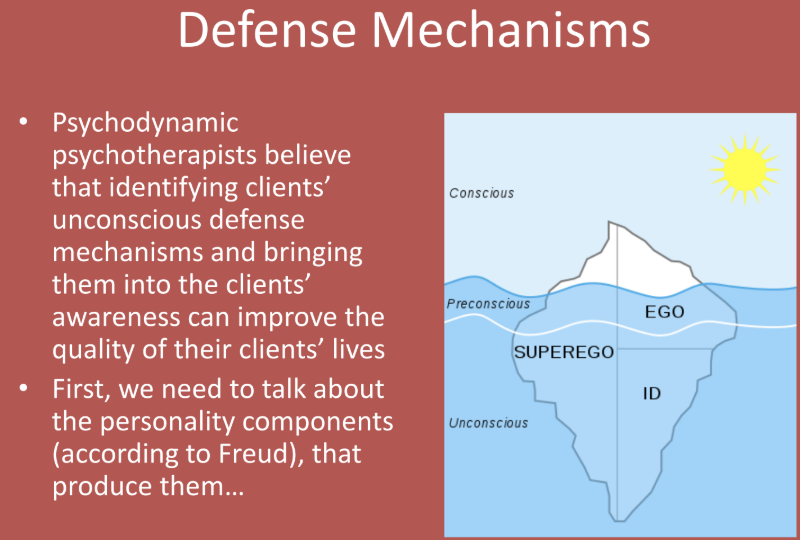
What is Freud's structural model of the mind? (Freud’s Structural Model of the Mind)
Freud's structural model of the mind involves three forces that interact largely outside our awareness: the id, superego, and ego.
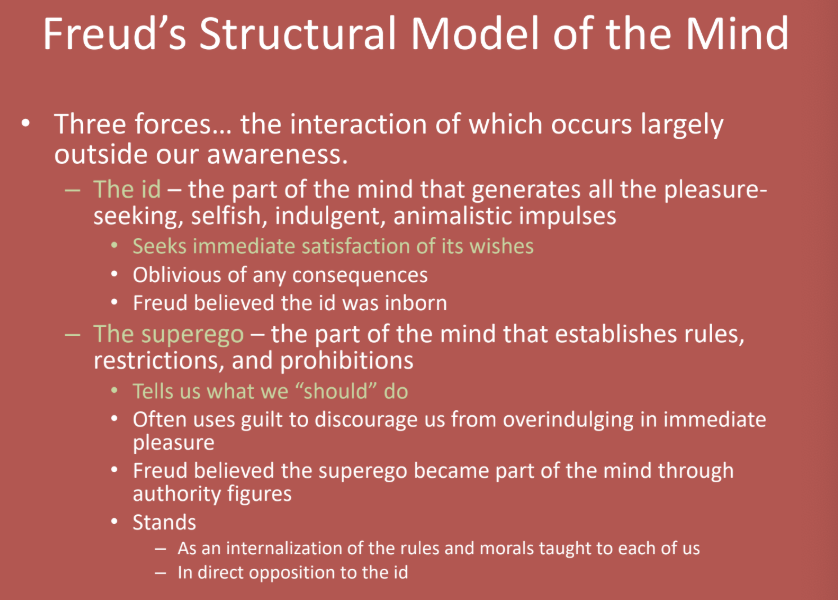
What are the three forces in Freud's structural model of the mind? (Freud’s Structural Model of the Mind)
The three forces in Freud's structural model of the mind are:
Id – generates pleasure-seeking, selfish impulses
Superego – establishes moral rules and prohibitions
Ego – mediates between the id and superego, managing conflict and reality demands.
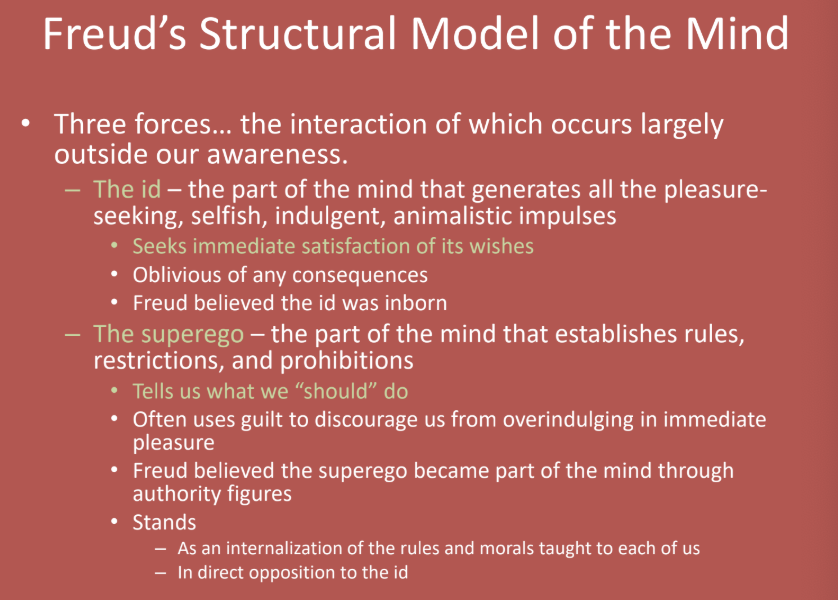
What is the ID? (Freud’s Structural Model of the Mind)
The id is the part of the mind that generates pleasure-seeking, selfish, and animalistic impulses, seeking immediate satisfaction of its wishes without regard for consequences. Freud believed it was inborn.
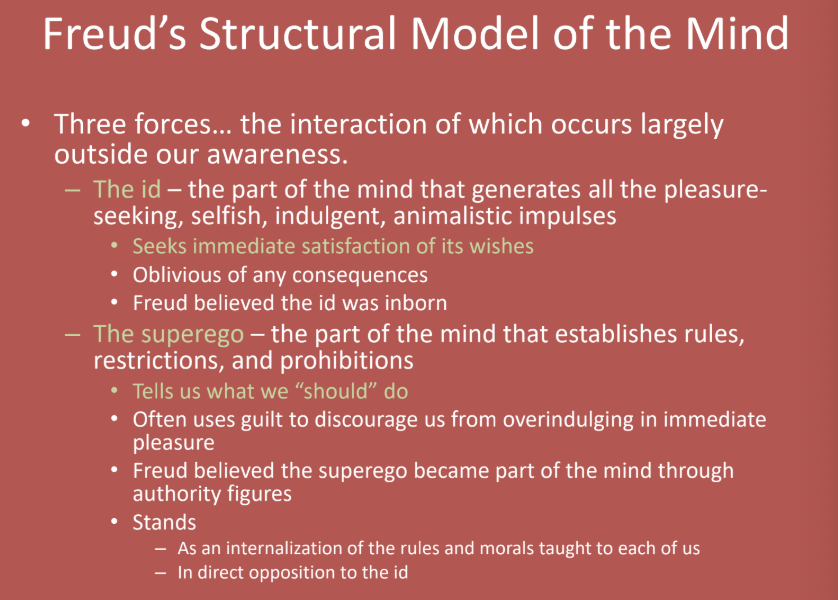
What is the superego? (Freud’s Structural Model of the Mind)
The superego is the part of the mind that establishes rules, restrictions, and moral prohibitions, telling us what we "should" do, often using guilt to prevent indulgence in immediate pleasures.
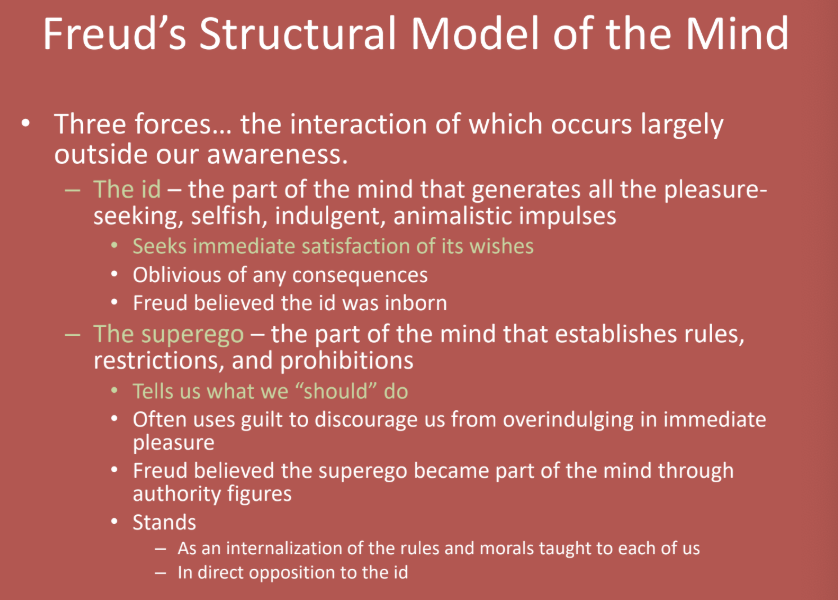
What is there a constant battle between in Freud's model? (Freud’s Structural Model of the Mind)
There is a constant battle between the id, which demands instant gratification, and the superego, which demands restraint and adherence to moral standards.
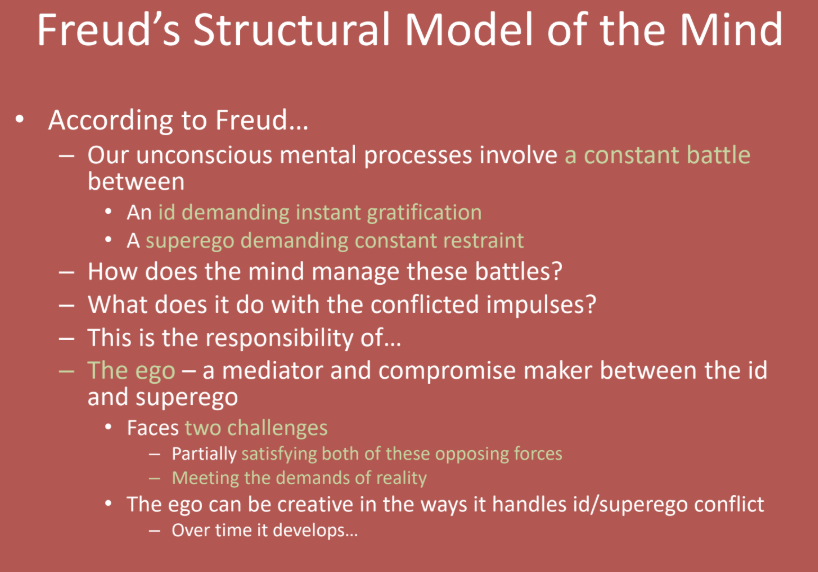
What is the ego? (Freud’s Structural Model of the Mind)
The ego is the part of the mind that mediates and makes compromises between the id and superego, managing conflict and making decisions based on reality.

What are the two challenges the ego faces? (Freud’s Structural Model of the Mind)
The ego faces two challenges:
Partially satisfying both the id and superego
Meeting the demands of reality while managing the id/superego conflict.
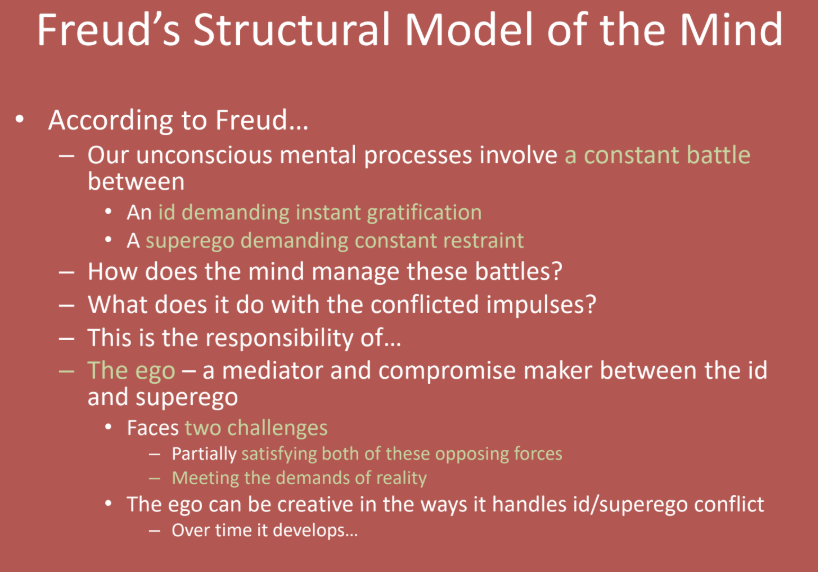
What are defense mechanisms? (Defense Mechanisms)
Defense mechanisms are techniques used by the ego to manage conflict between the id and superego and to protect the individual from anxiety and emotional distress.
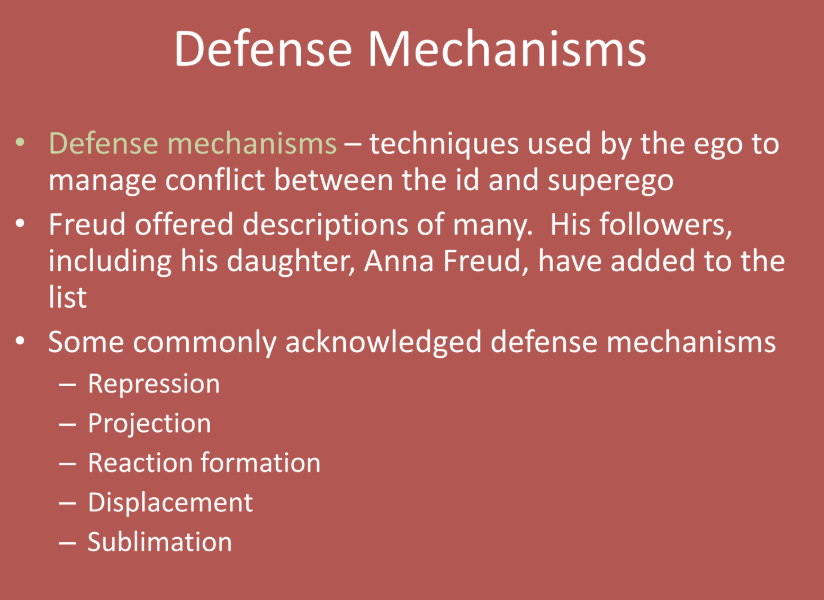
What are some commonly acknowledged defense mechanisms? (Defense Mechanisms)
Some commonly acknowledged defense mechanisms include:
Repression
Projection
Reaction formation
Displacement
Sublimation
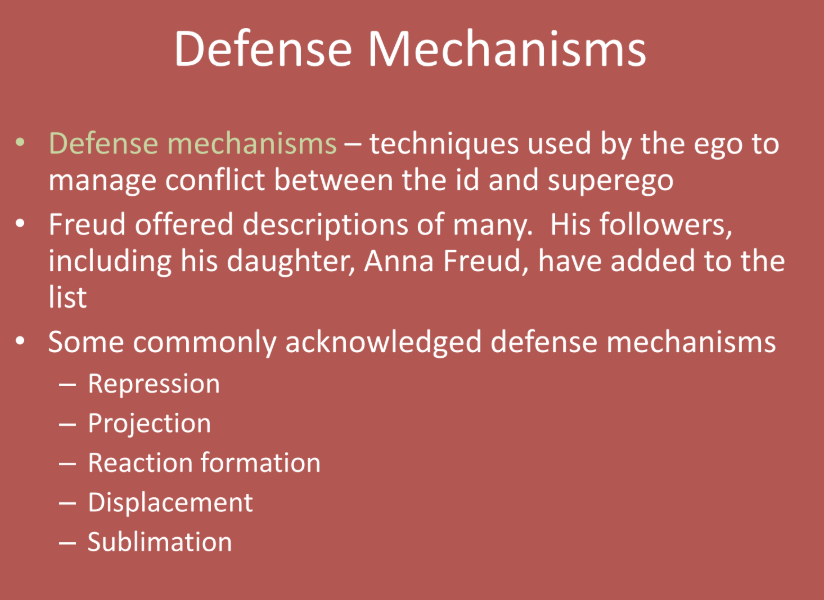
What is repression? (Defense Mechanisms: Repression)
Repression is when the ego prevents unacceptable impulses or conflicts between the id and superego from entering conscious awareness, essentially "sweeping them under the rug."
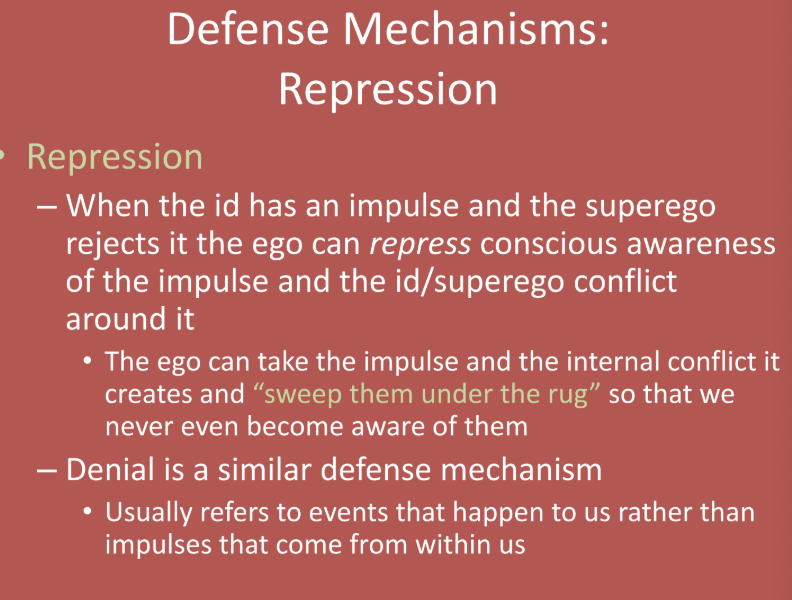
What is repression similar to? (Defense Mechanisms: Repression)
Repression is similar to denial, which refers to rejecting awareness of external events or situations, rather than internal conflicts like those addressed in repression.
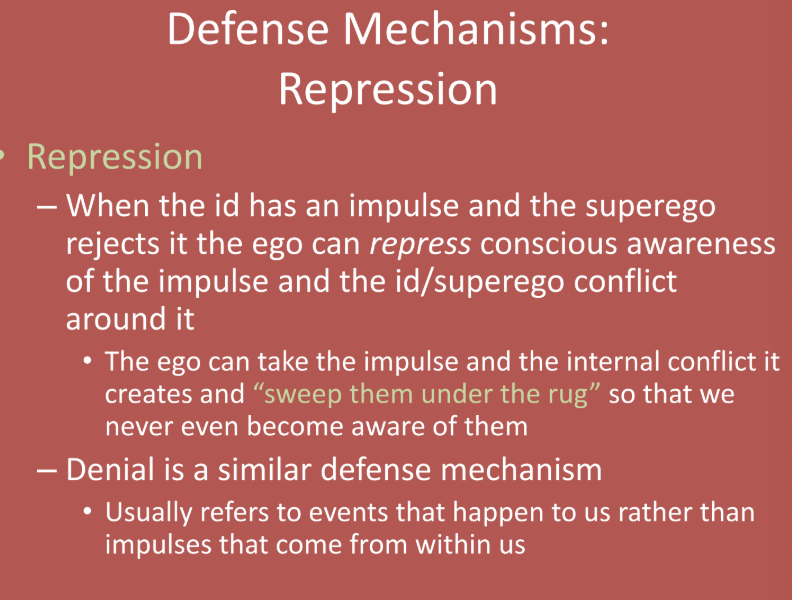
What is projection? (Defense Mechanisms: Projection)
Projection occurs when the ego attributes unacceptable impulses from the id to other people, convincing ourselves that these impulses belong to others, not us.
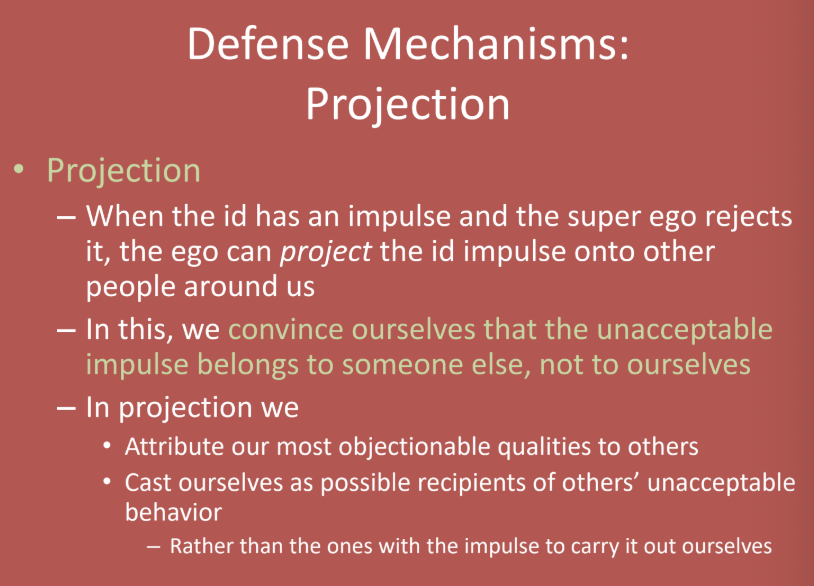
What do we do in projection? (Defense Mechanisms: Projection)
In projection, we convince ourselves that the unacceptable impulse belongs to someone else, not to ourselves
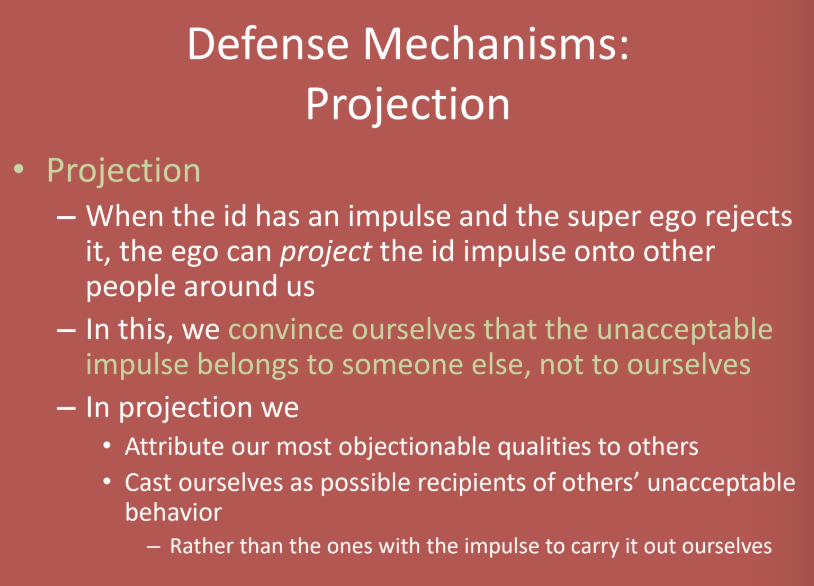
What is reaction formation? (Defense Mechanisms: Reaction Formation)
Reaction formation occurs when the ego forms a reaction against the id's impulse, essentially doing the exact opposite of what the id urges. For example, if the id urges selfish behavior, the ego promotes selfless behavior instead.
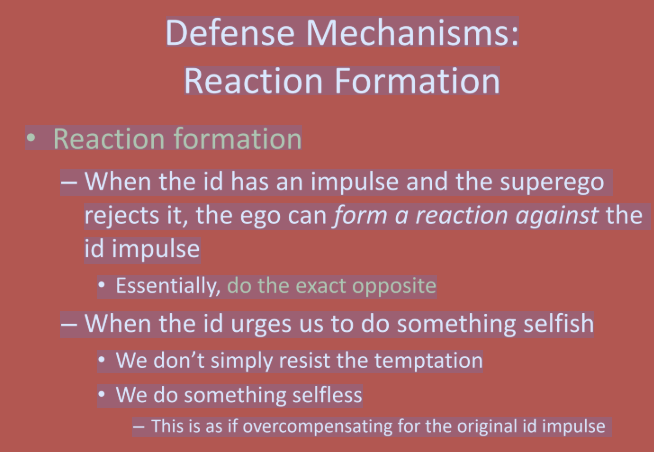
What defense mechanism is reaction formation the opposite of? (Defense Mechanisms: Reaction Formation)
Reaction formation is the opposite of projection, where instead of attributing unacceptable impulses to others, the ego reacts by doing the opposite of the impulse, overcompensating with behaviors that contradict the original desire.
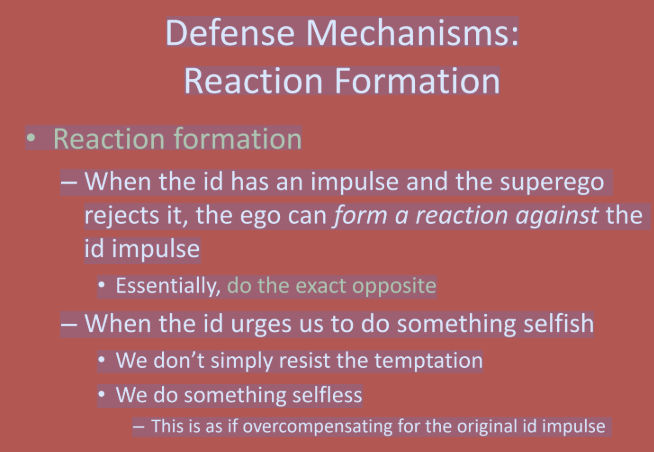
What happens in the id when reaction formation urges us to do something selfish? (Defense Mechanisms: Reaction Formation)
When the id urges us to do something selfish, reaction formation causes us to overcompensate by doing something selfless, essentially acting in opposition to the selfish impulse in an exaggerated way.

What is displacement? (Defense Mechanisms: Displacement)
Displacement occurs when the ego redirects an id impulse toward a safer target. Instead of acting on the original impulse toward its intended recipient, the impulse is shifted to a different person or object to avoid conflict or repercussions.
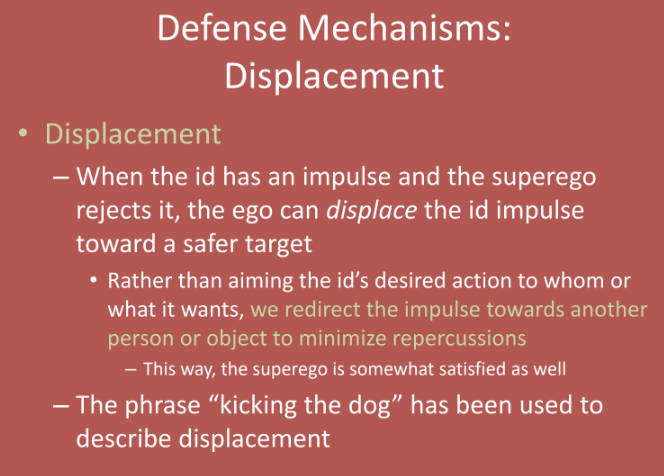
What is sublimation? (Defense Mechanisms: Sublimation)
Sublimation occurs when the ego redirects an id impulse in a way that results in behavior that benefits others. Instead of harming others, the behavior channeled from the id impulse helps people, making it a socially acceptable and positive expression of that urge.
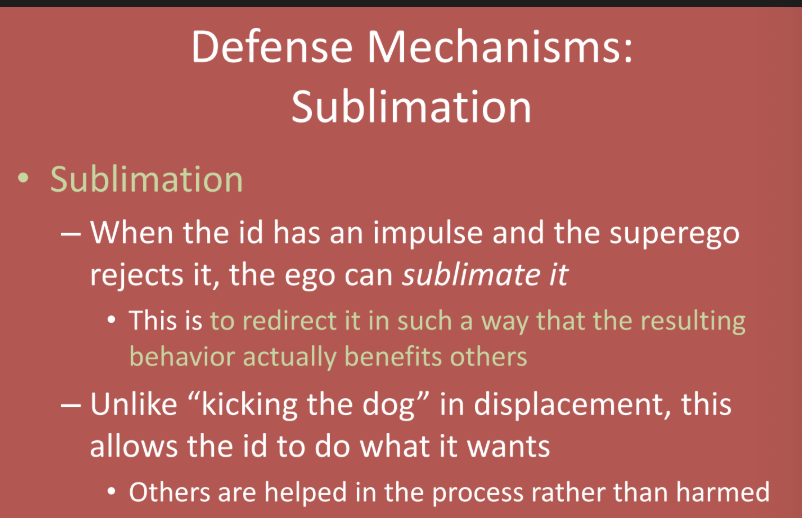
How is sublimation different from displacement? (Defense Mechanisms: Sublimation)
Sublimation redirects an id impulse into behavior that benefits others, while displacement redirects an id impulse toward a safer target but does not necessarily lead to positive outcomes for others.
Sublimation is constructive, whereas displacement may harm others or be less productive.

What is an example of taking an id impulse of physical aggression in the 5 defense mechanisms? (Defense Mechanisms)
Repression: The ego represses the impulse, and you're unaware of it.
Projection: You believe someone else has the impulse to attack, not you.
Reaction Formation: You act in the opposite way, being excessively gentle.
Displacement: You redirect the impulse by hitting a friend, family member, or punching bag instead of the intended target.
Sublimation: You channel the aggression into a career, such as becoming a surgeon, where physical force helps others in a healing way.
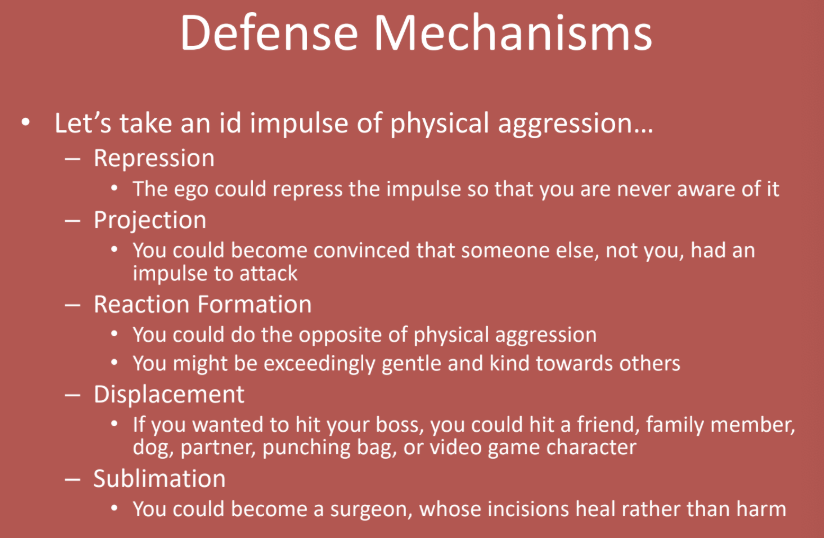
What do psychodynamic psychotherapists believe about defense mechanisms? (Defense Mechanisms)
Psychodynamic psychotherapists believe that some defense mechanisms are more mature/healthier than others
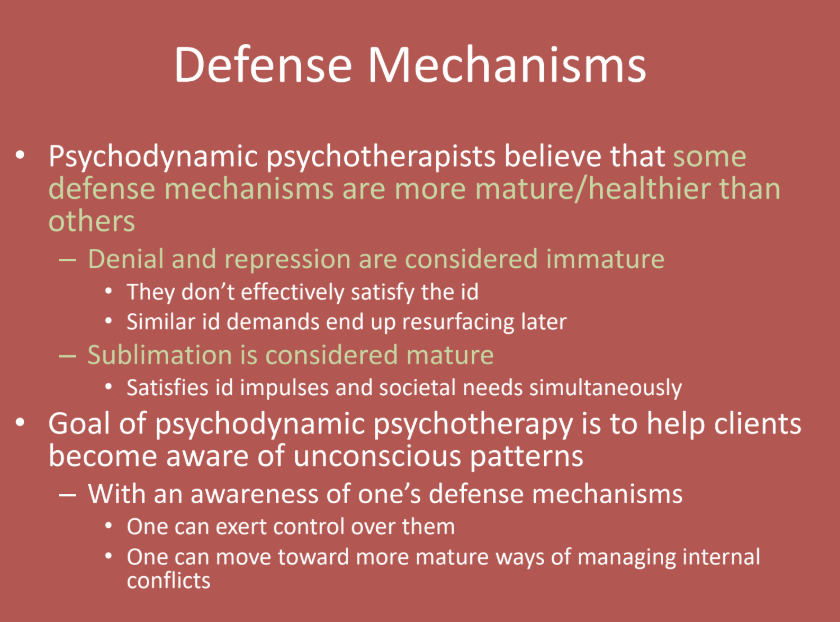
What defense mechanisms are considered immature? (Defense Mechanisms)
Denial and repression are considered immature defense mechanisms because they don't effectively satisfy id impulses and often lead to the id's demands resurfacing later.

Which defense mechanisms are considered mature? (Defense Mechanisms)
Sublimation is considered a mature defense mechanism because it channels id impulses into behaviors that not only satisfy id demands but also serve societal and constructive needs.
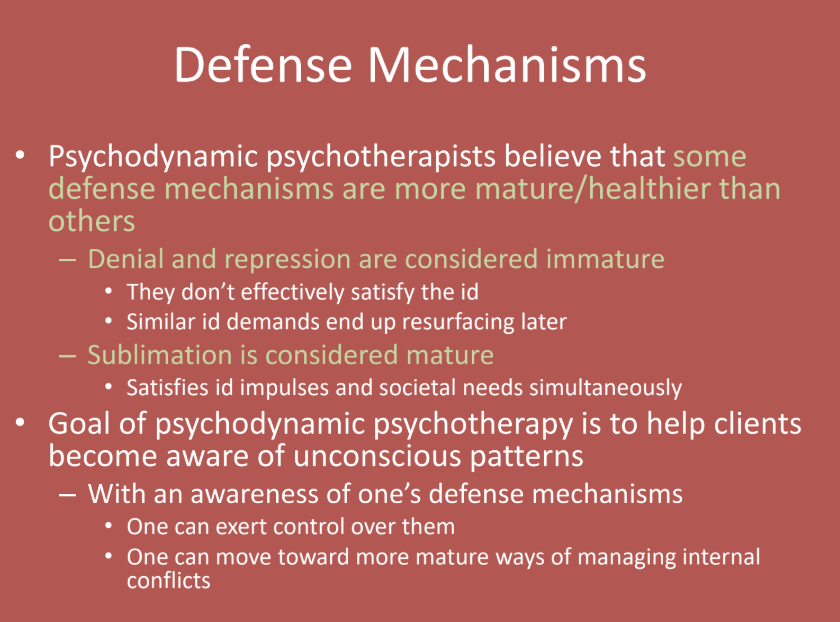
What part of the mind is considered more animalistic rather than human? (Defense Mechanisms)
The id is considered more animalistic rather than human, as it represents basic, primal impulses and desires without concern for social rules or consequences.
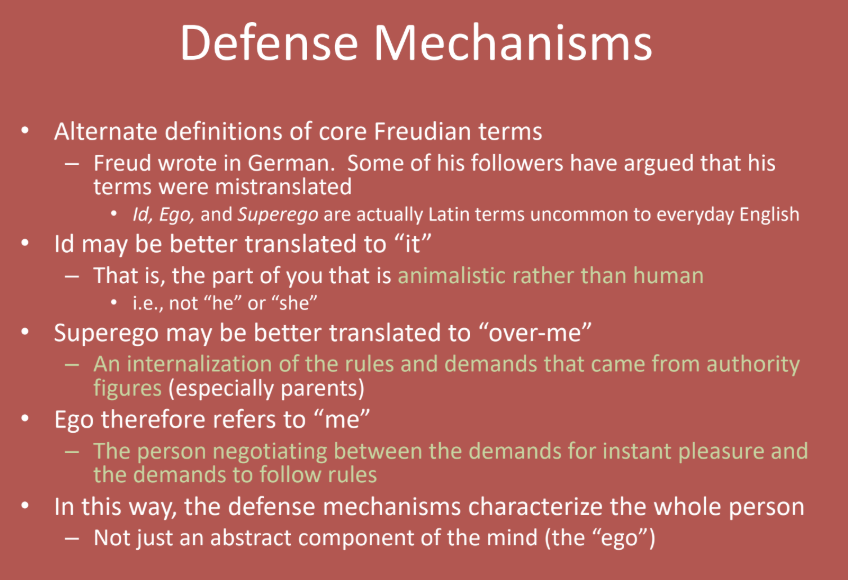
What is the superego translated to? (Defense Mechanisms)
The superego may be better translated to "over-me," representing the internalization of rules and demands from authority figures, especially parents.
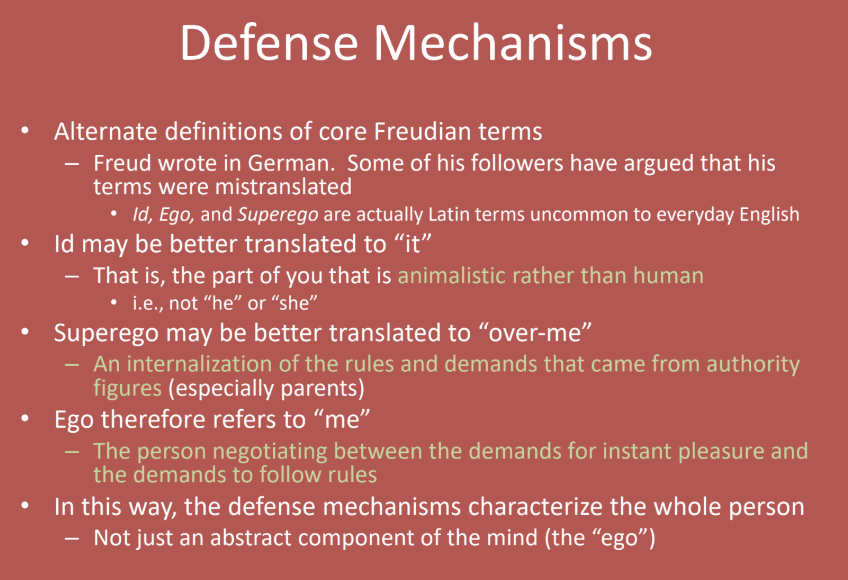
What is the ego referred to as? (Defense Mechanisms)
The ego is referred to as "me," the part of the personality that negotiates between the id's demand for instant pleasure and the superego's moral rules.
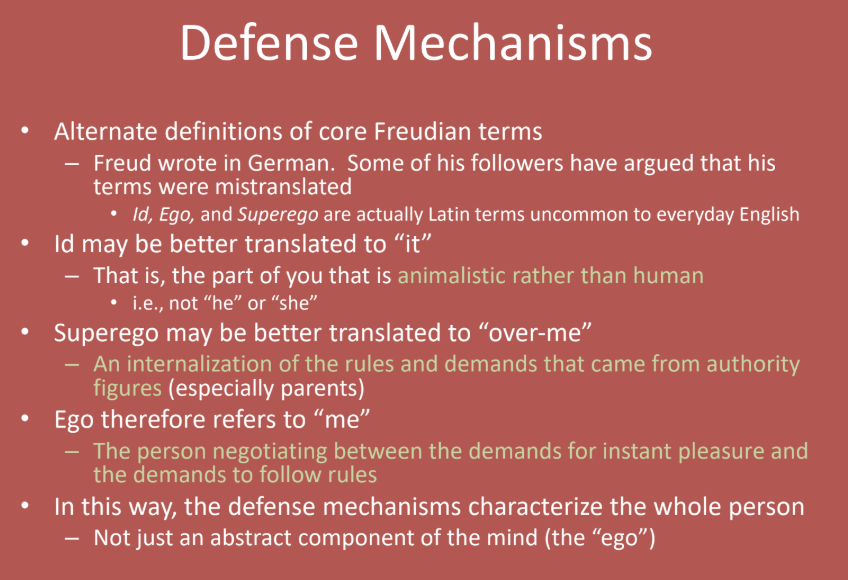
What is transference in psychodynamic psychotherapy? (Transference)
Transference is when clients unconsciously transfer feelings, expectations, and assumptions from past relationships onto their therapist, often expecting the therapist to behave like important figures from their past.
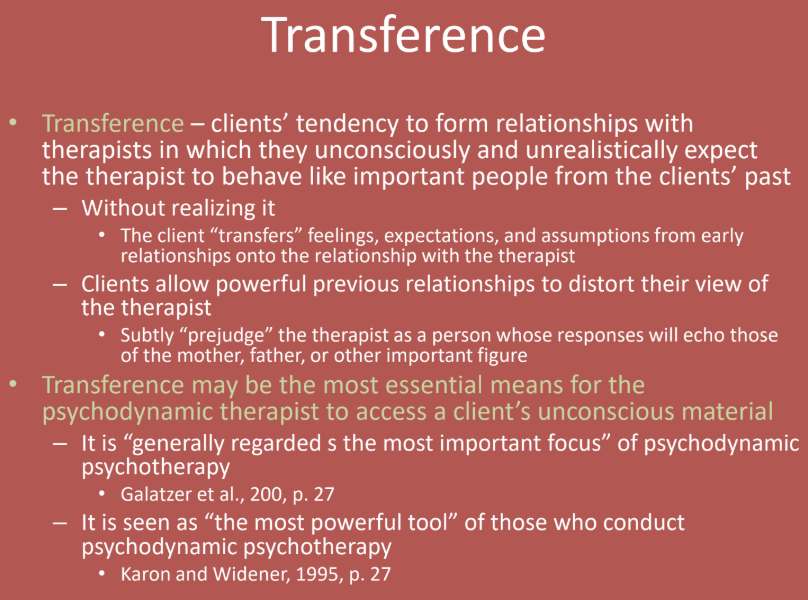
What is the most essential means for psychodynamic therapists to access a client's unconscious material? (Transference)
Transference is generally regarded as the most important and powerful means for psychodynamic therapists to access a client’s unconscious material.
It is “generally regarded s the most important focus” of psychodynamic psychotherapy

What is countertransference? (CounterTransference)
Countertransference occurs when therapists unconsciously transfer their own personal feelings or experiences onto the client, often distorting their responses.
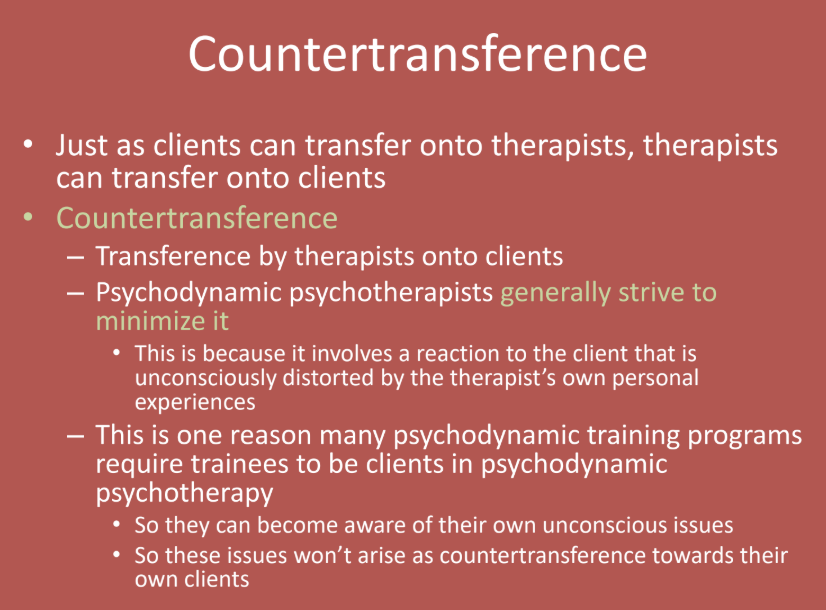
Do psychodynamic therapists strive to maximize or minimize countertransference, and why? (CounterTransference)
Psychodynamic therapists strive to minimize countertransference, as it involves distorted reactions based on the therapist’s own unconscious issues, which can interfere with the therapeutic process.
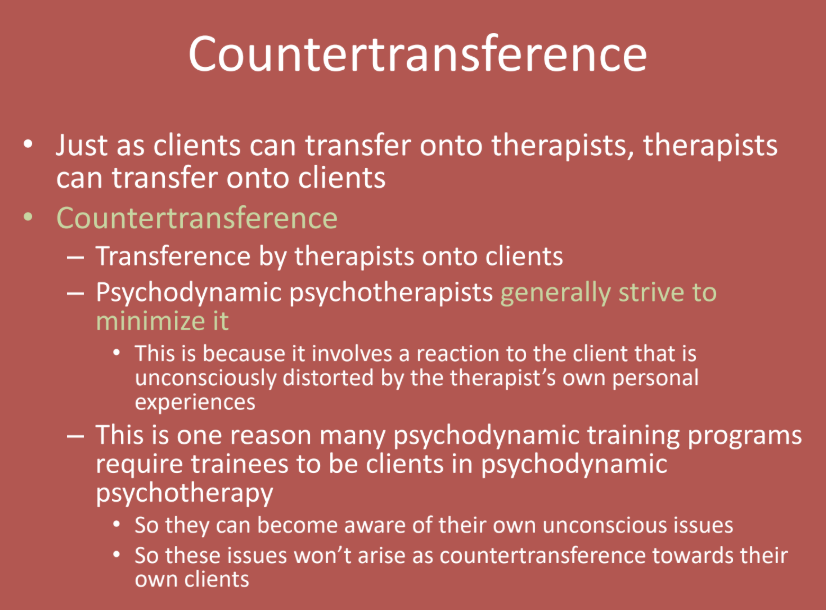
What are Freud's psychosexual stages? (Psychosexual Stages: Clinical Implications)
Freud’s psychosexual stages are oral, anal, phallic, latency, and genital, which are stages of development through which a child’s personality evolves.
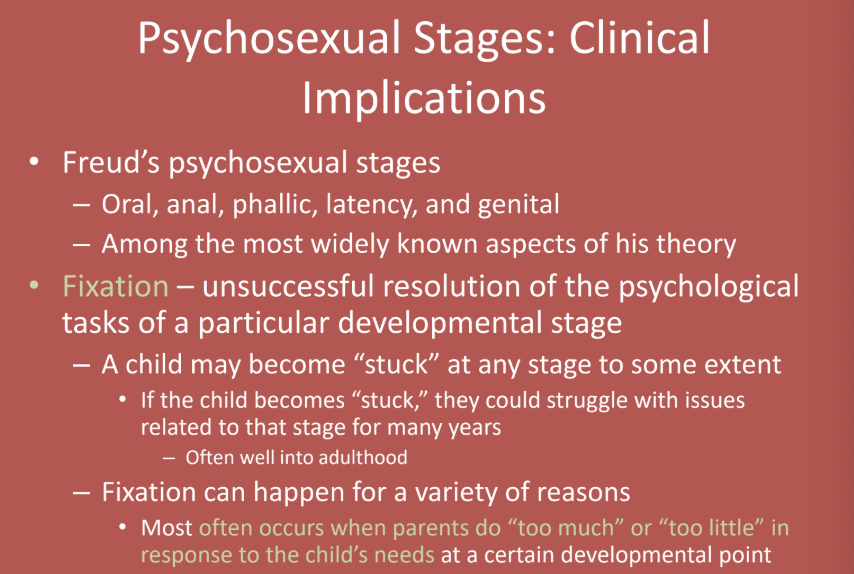
What is fixation in Freud’s theory? (Psychosexual Stages: Clinical Implications)
Fixation occurs when a child becomes “stuck” at a particular psychosexual stage, leading to unresolved issues related to that stage, which can affect the individual later in life.
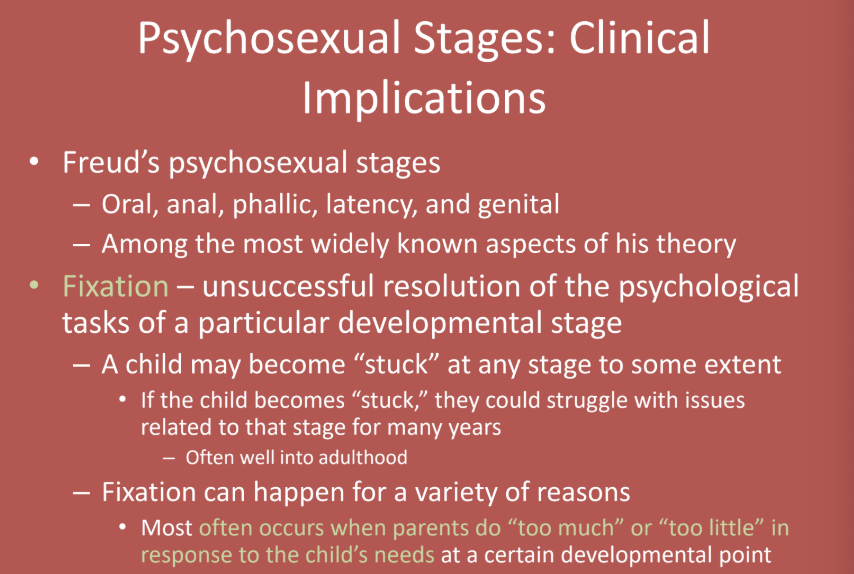
Why does fixation most often occur? (Psychosexual Stages: Clinical Implications)
Fixation most often occurs when parents do "too much" or "too little" in response to a child’s needs at a certain developmental stage, preventing the child from resolving psychological tasks effectively.
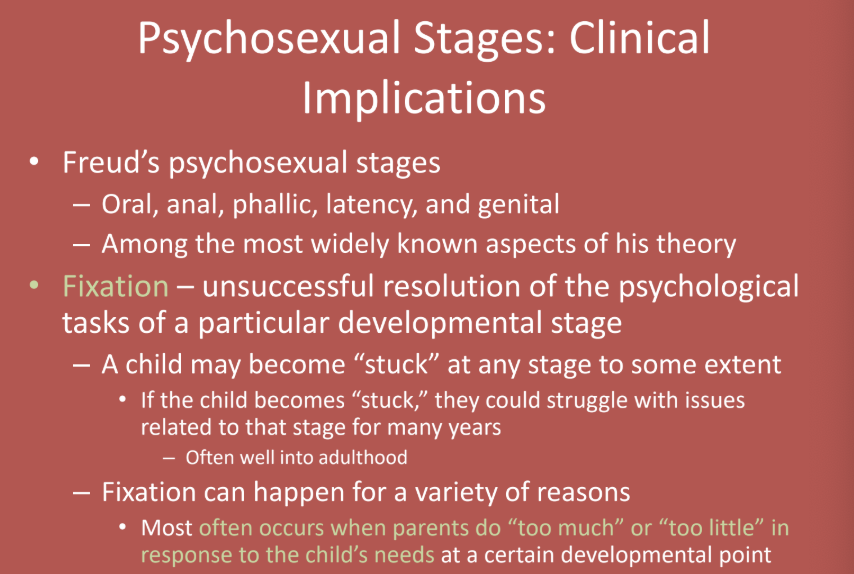
What is the oral stage in Freud’s psychosexual theory? (Psychosexual Stages: The Oral Stage)
The oral stage is the first psychosexual stage, during which issues of dependency may emerge, and the child experiences all pleasurable sensations through the mouth, primarily through feeding.

When does the oral stage occur? (Psychosexual Stages: The Oral Stage)
The oral stage occurs during the first year and a half of a child’s life.
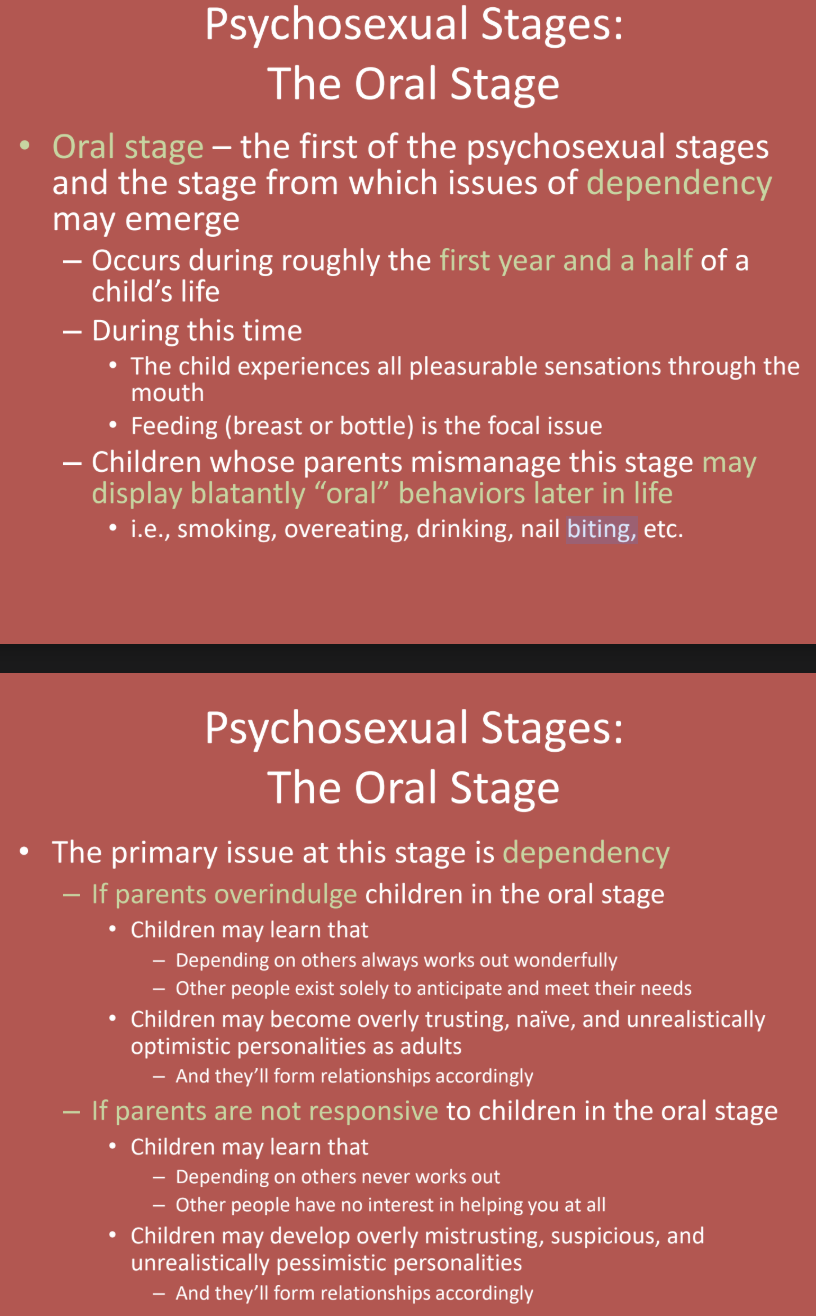
What happens to children whose parents mismanage the oral stage? (Psychosexual Stages: The Oral Stage)
Children whose parents mismanage the oral stage may develop oral behaviors later in life, such as smoking, overeating, drinking, and nail biting.

What is the primary issue of the oral stage? (Psychosexual Stages: The Oral Stage)
The primary issue of the oral stage is dependency, as the child learns to depend on others for nourishment and comfort.
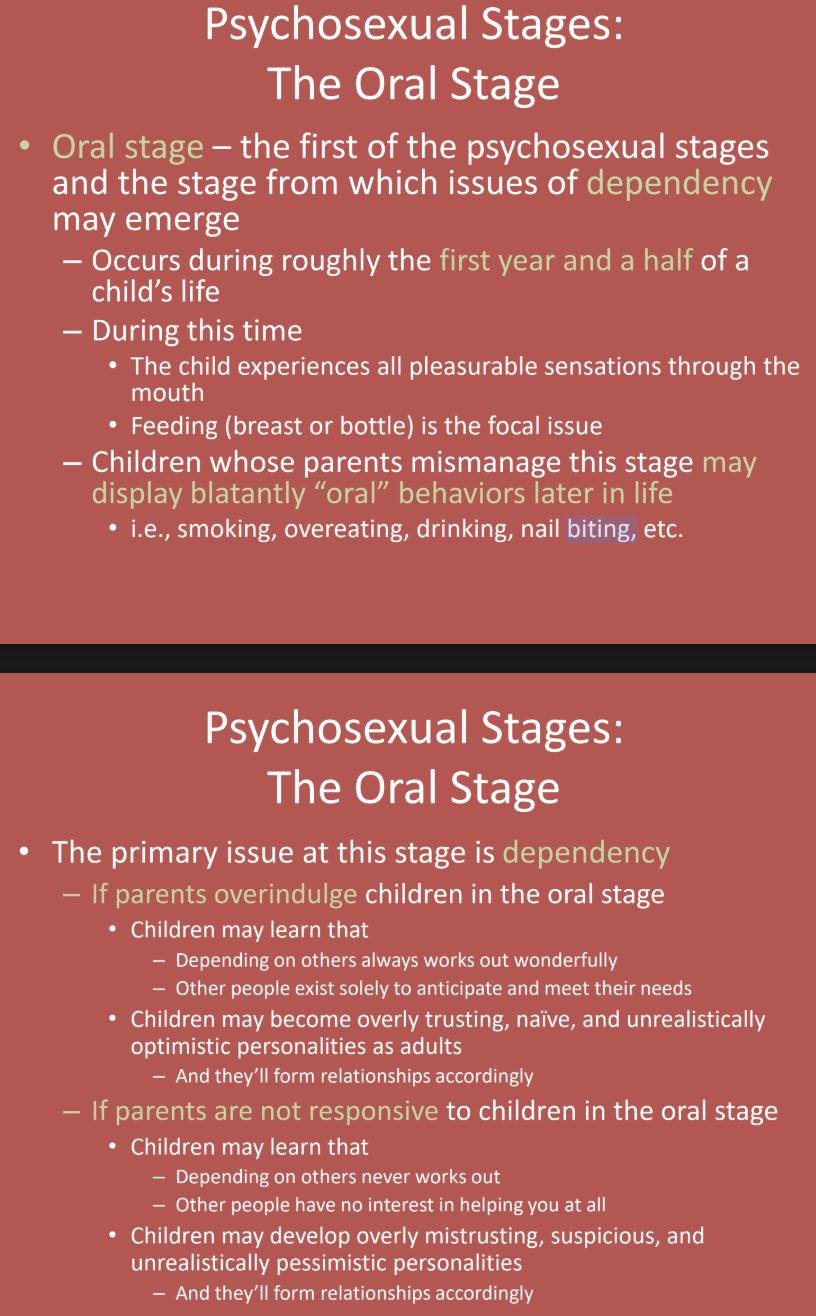
What happens if parents overindulge during the oral stage? (Psychosexual Stages: The Oral Stage)
If parents overindulge, children may learn that depending on others always works out wonderfully, which may lead them to become overly trusting, naïve, and unrealistically optimistic in adulthood.
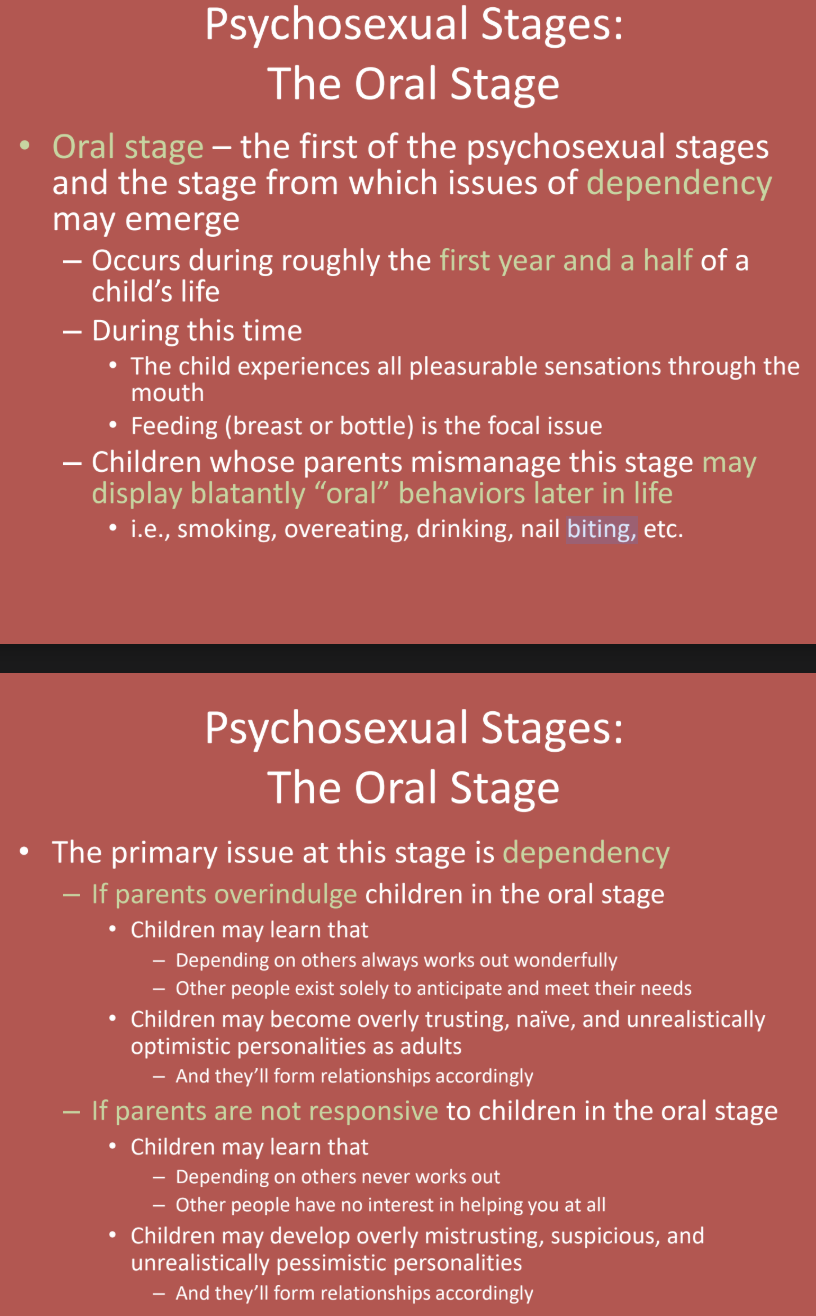
What happens if parents are not responsive during the oral stage? (Psychosexual Stages: The Anal Stage)
If parents are unresponsive, children may learn that depending on others never works out, leading to overly mistrusting, suspicious, and pessimistic personalities as adults.
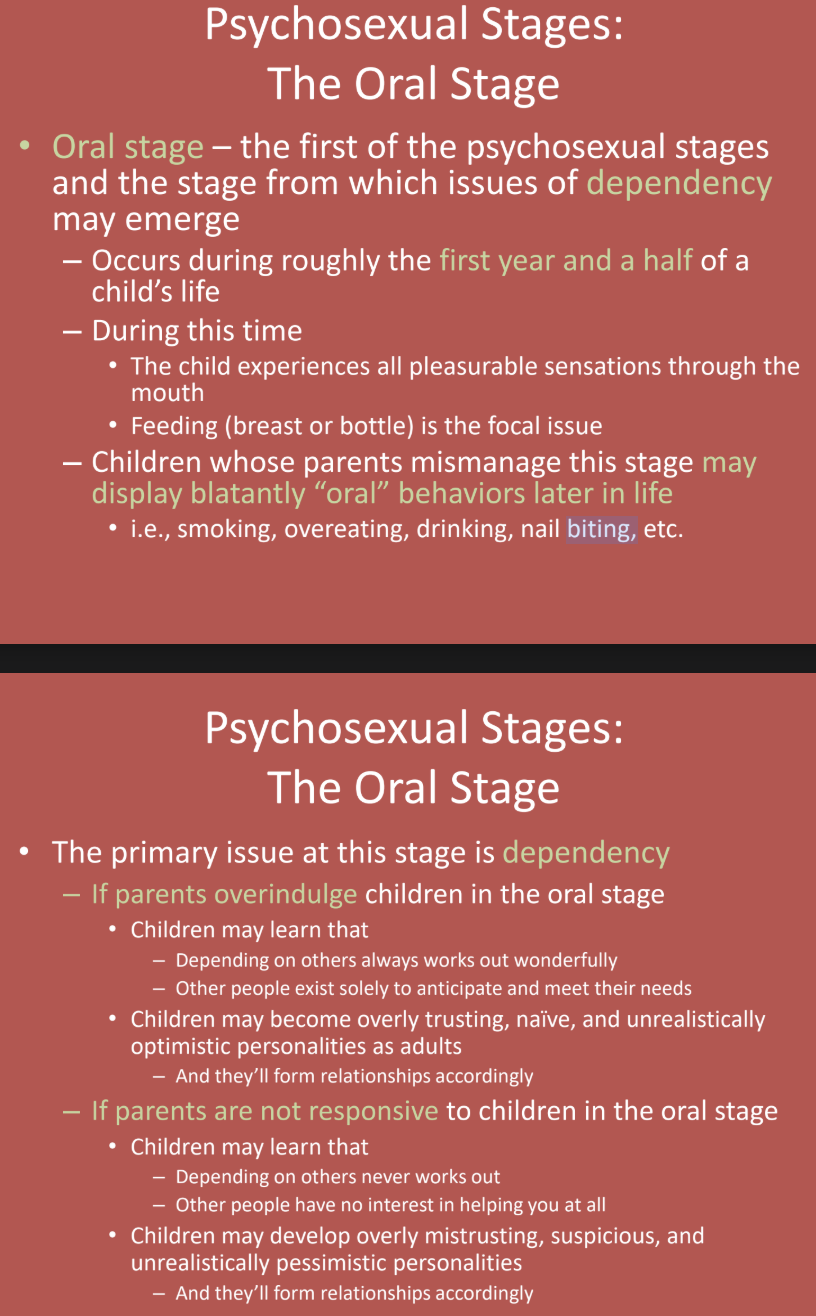
What is the anal stage in Freud’s psychosexual theory? (Psychosexual Stages: The Anal Stage)
The anal stage is the second of the psychosexual developmental stages, where issues of control may emerge, and children are learning to control themselves in many ways, with toilet training being the central issue.
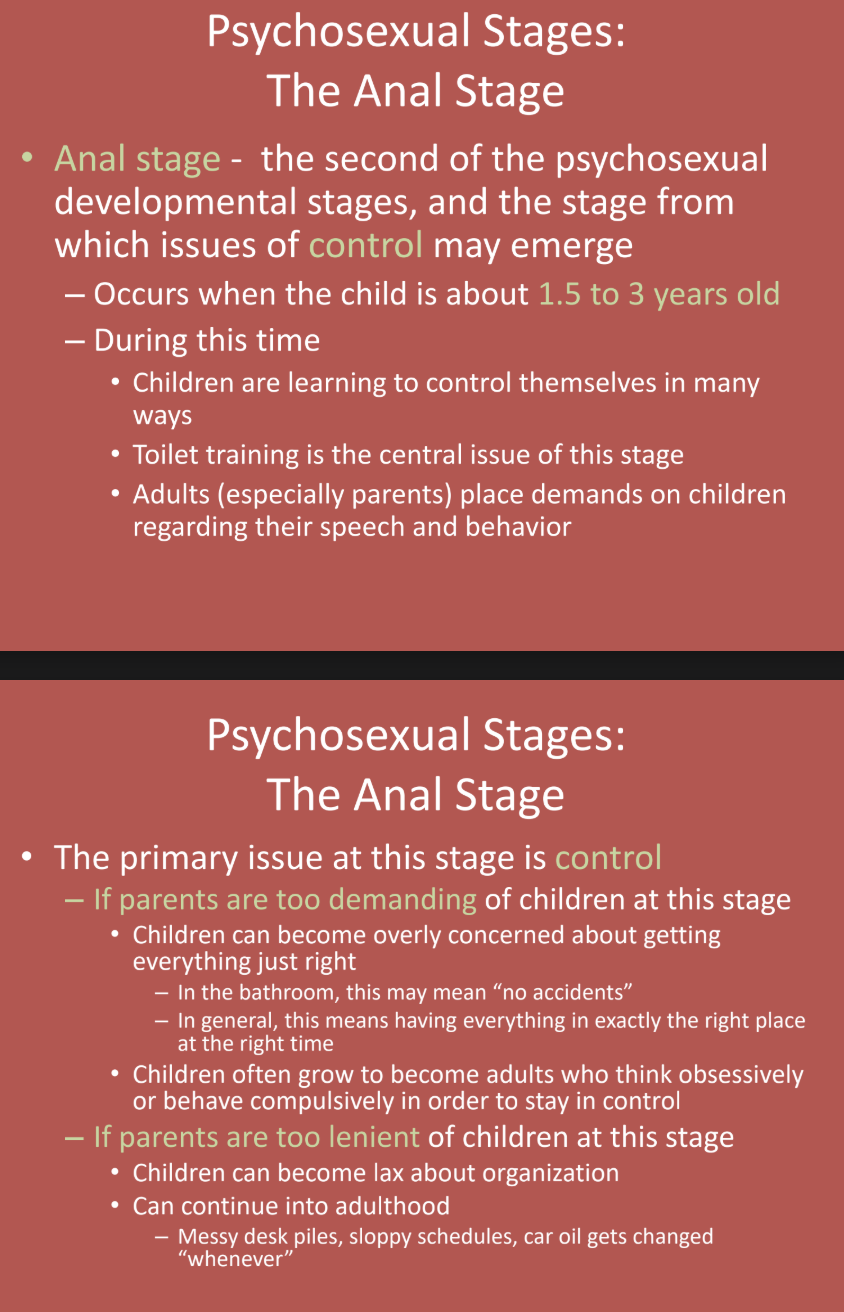
When does the anal stage occur? (Psychosexual Stages: The Anal Stage)
The anal stage occurs when the child is about 1.5 to 3 years old.
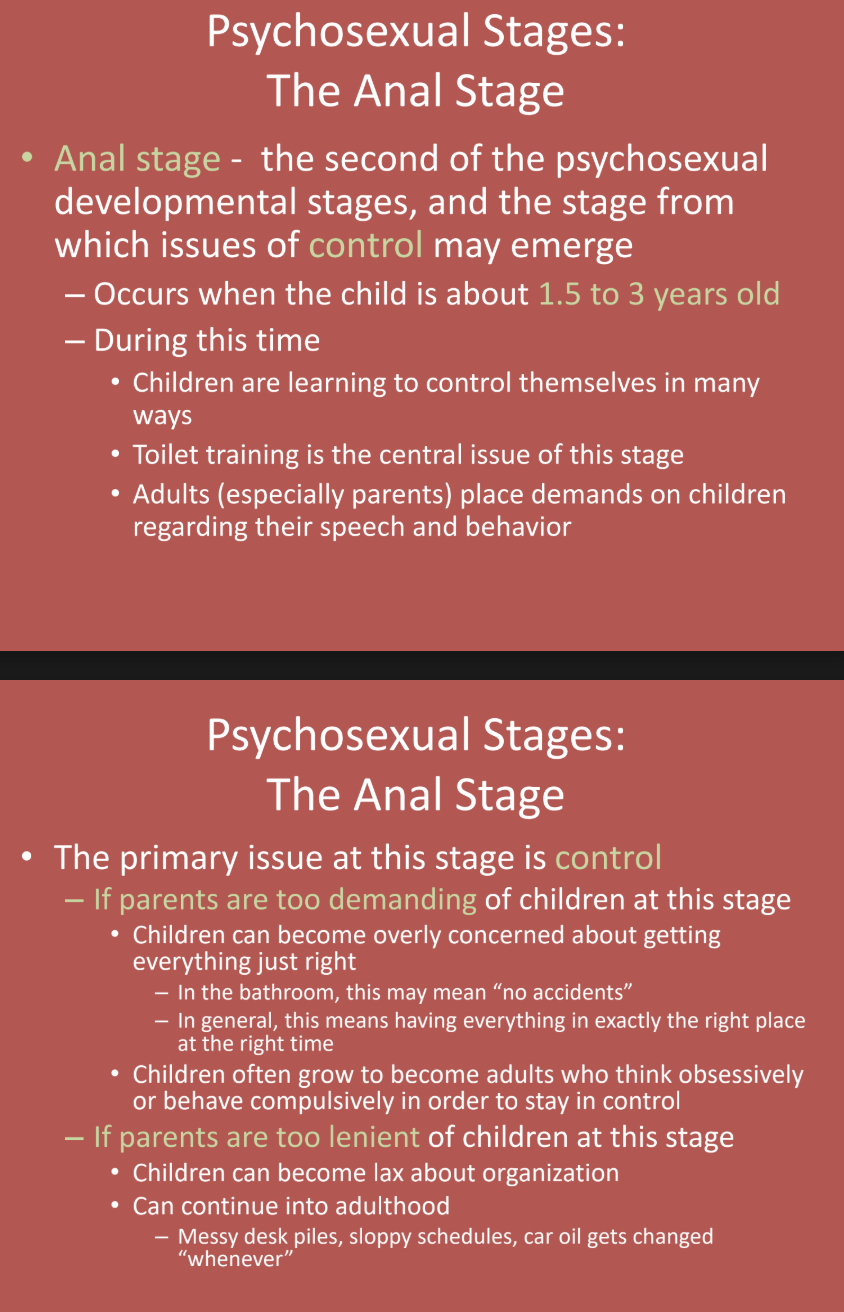
What happens during the anal stage? (Psychosexual Stages: The Anal Stage)
During the anal stage, children learn to control themselves in various ways, and toilet training becomes the central focus. Parents also place demands on children regarding their speech and behavior.

What is the primary issue of the anal stage? (Psychosexual Stages: The Anal Stage)
The primary issue of the anal stage is control.
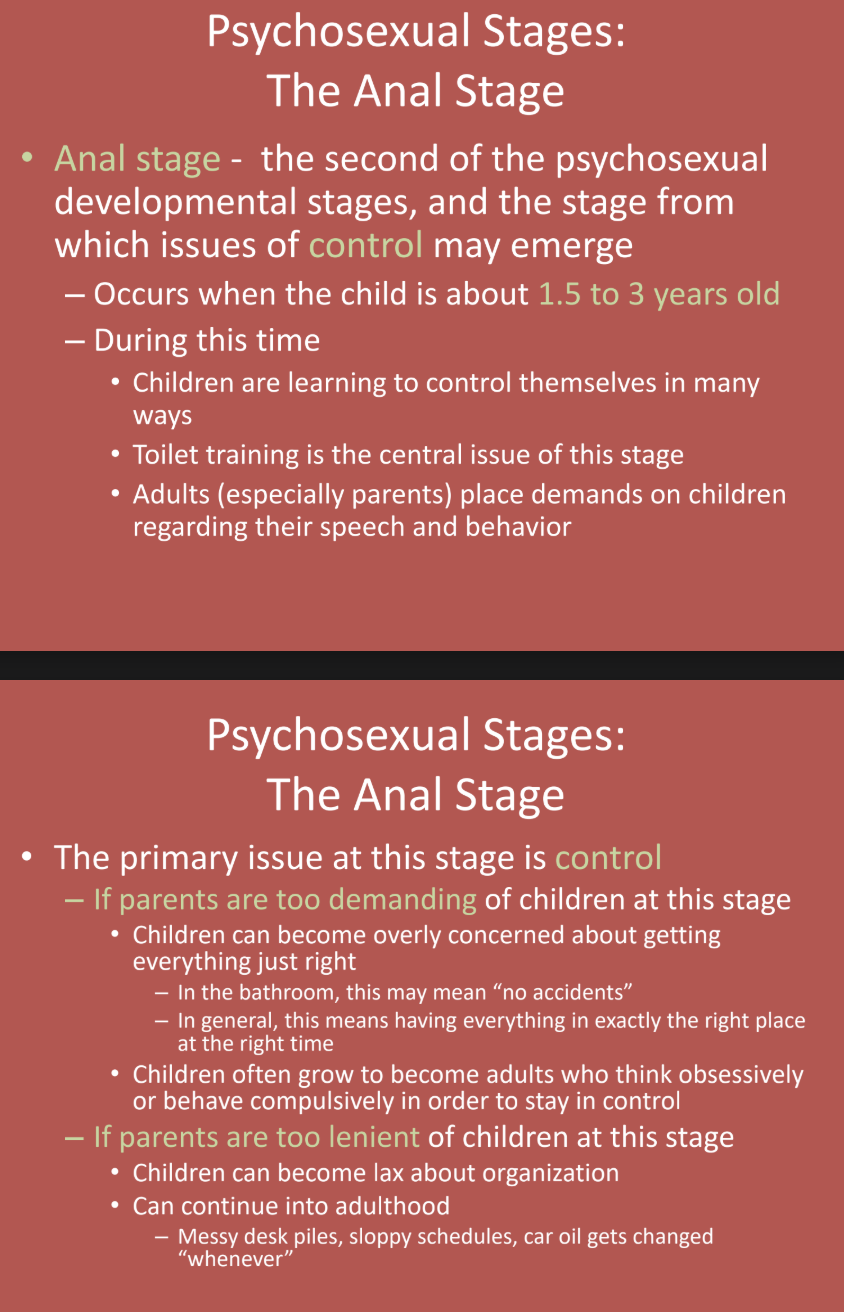
What happens if parents are too demanding during the anal stage? (Psychosexual Stages: The Anal Stage)
If parents are too demanding, children may become overly concerned about getting everything just right. This can lead to obsessive or compulsive behavior in adulthood, such as needing everything in its exact place.
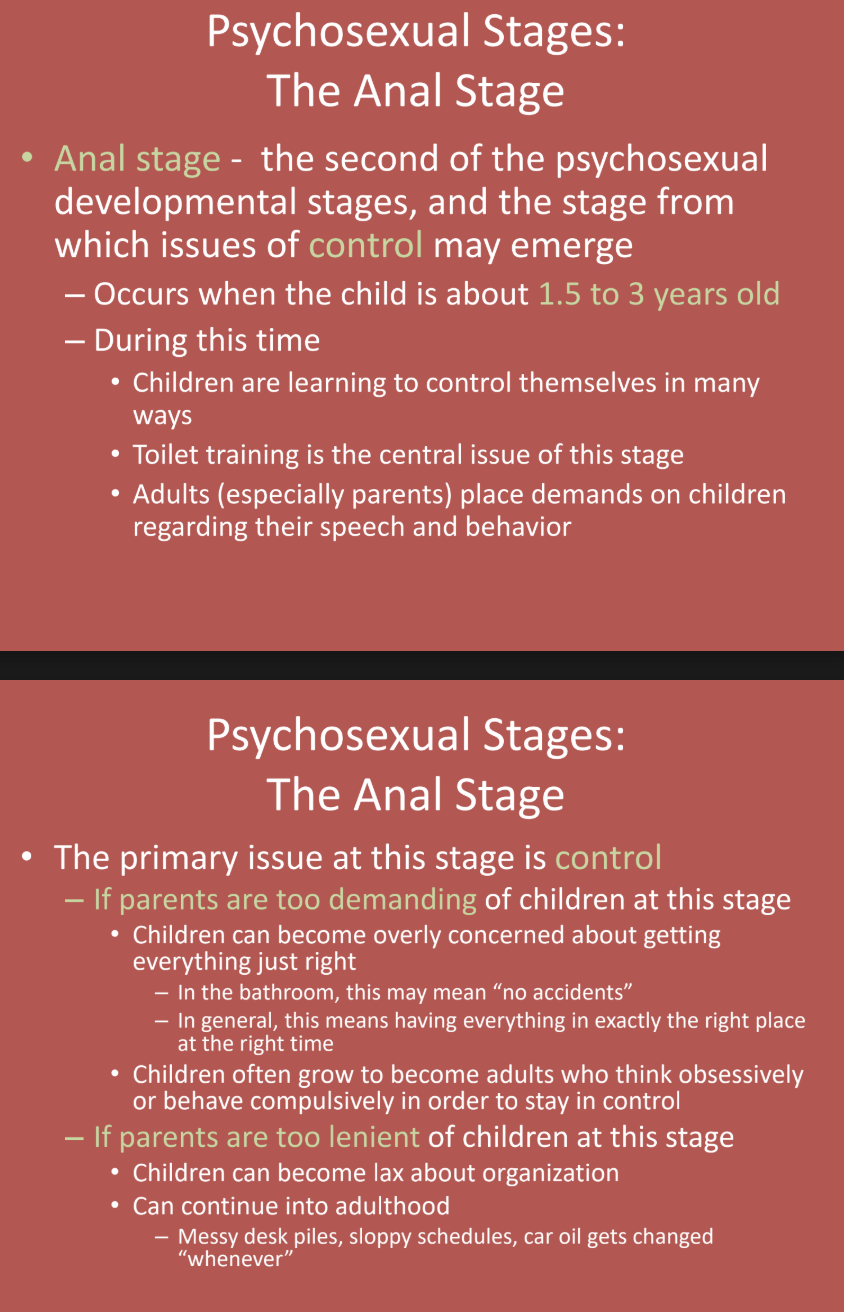
What happens if parents are too lenient during the anal stage? (Psychosexual Stages: The Anal Stage)
If parents are too lenient, children may become lax about organization, leading to messy habits that can persist into adulthood, such as disorganized workspaces or sloppy schedules.
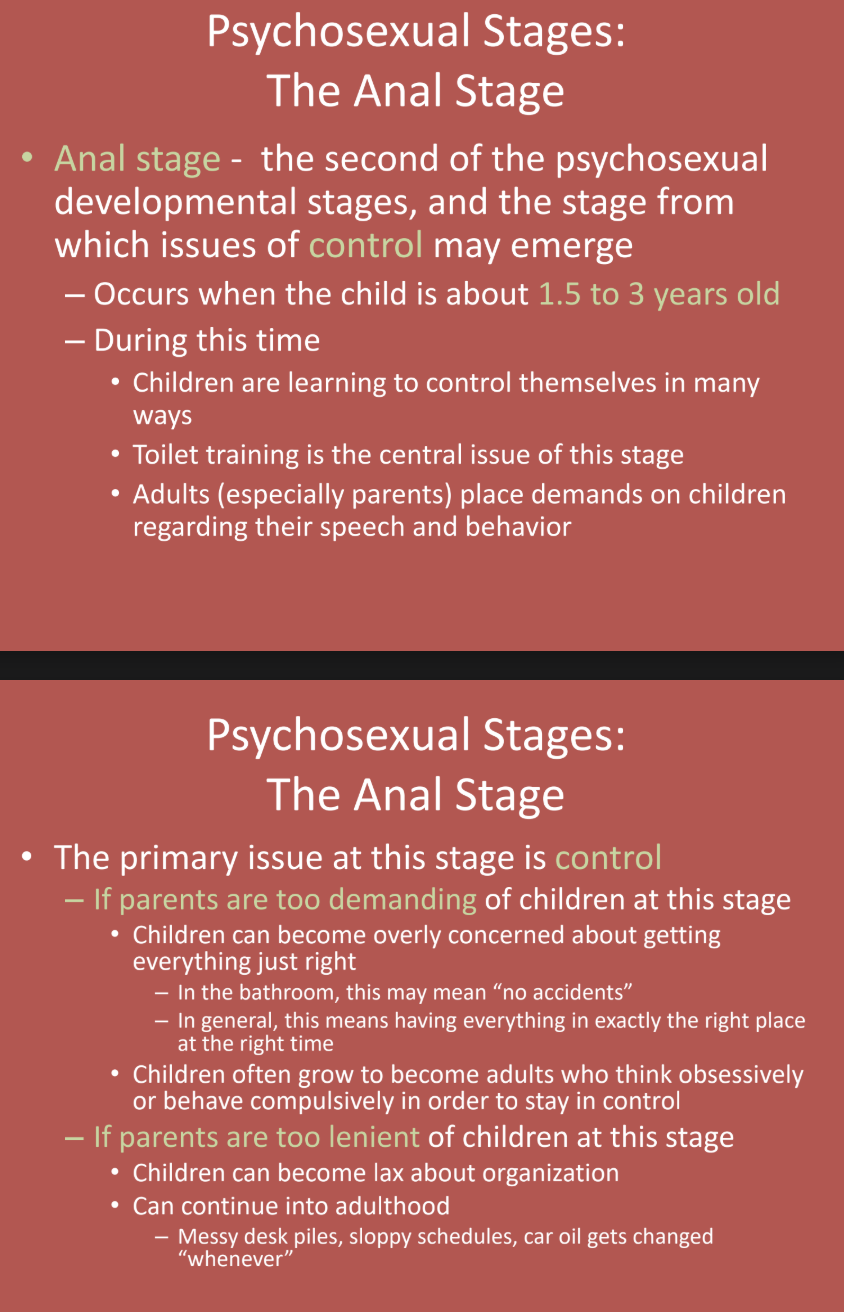
What is the phallic stage in Freud’s psychosexual theory? (Psychosexual Stages: The Phallic Stage)
The phallic stage is the third of the psychosexual stages, during which issues of self-worth may emerge, as children wish to have a special, close relationship with their parents.
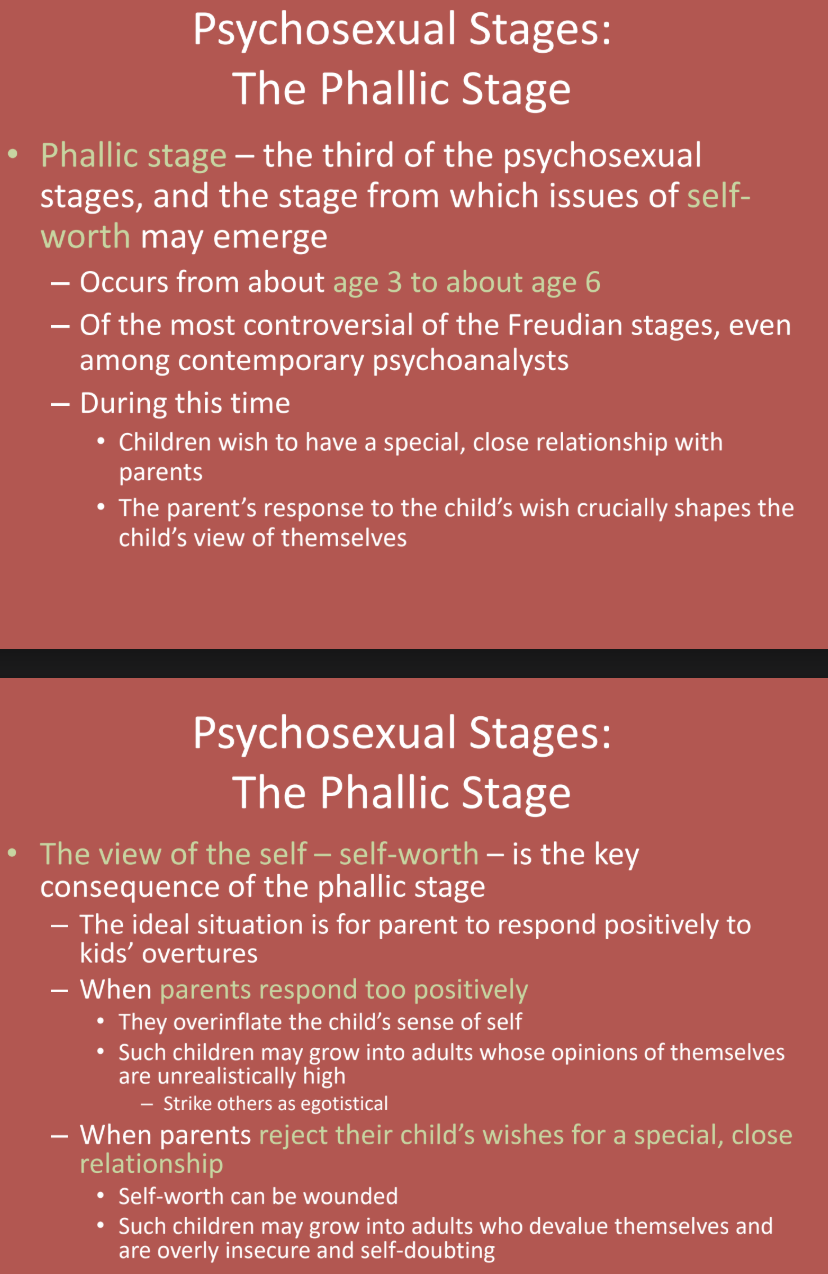
What ages does the phallic stage occur during? (Psychosexual Stages: The Phallic Stage)
The phallic stage occurs from about age 3 to age 6.
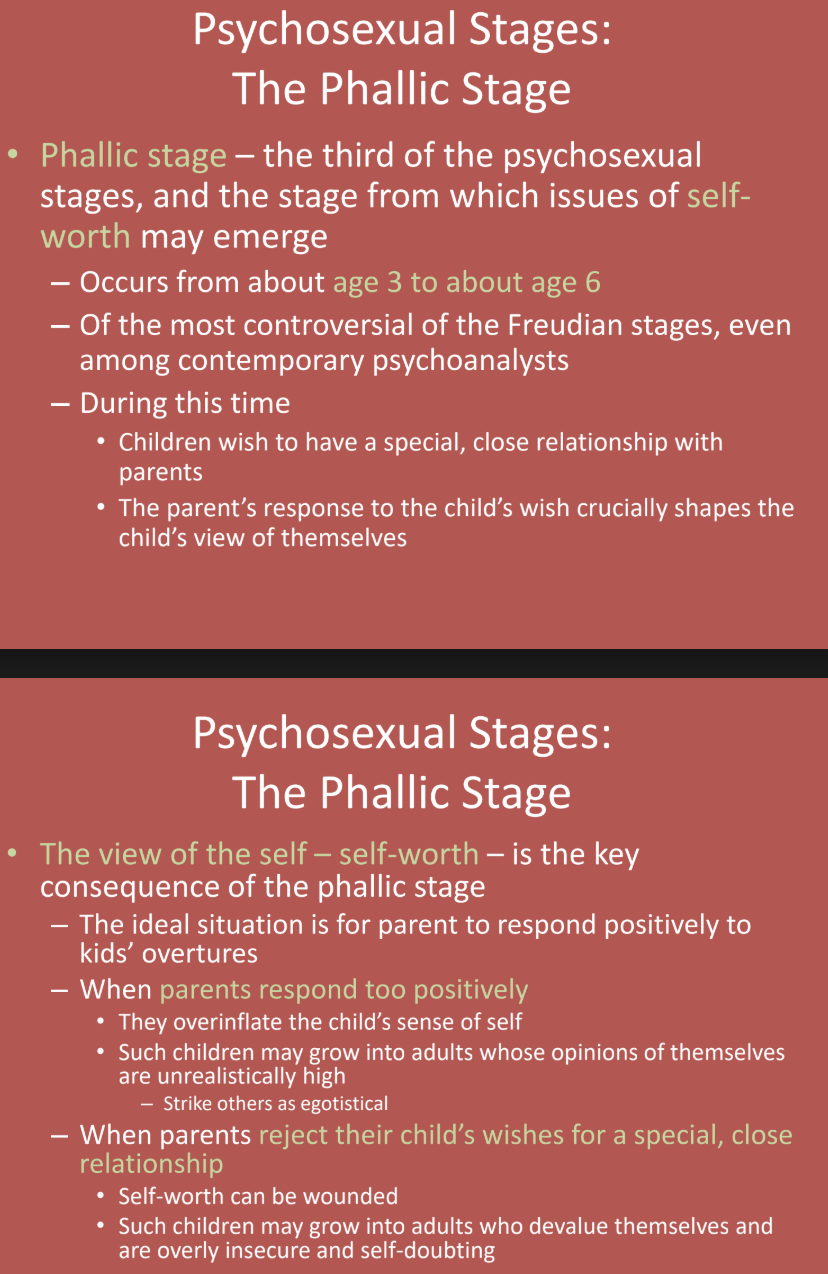
What happens during the phallic stage? (Psychosexual Stages: The Phallic Stage)
During the phallic stage, children desire a special, close relationship with their parents, and the parent’s response to these wishes shapes the child’s self-worth.
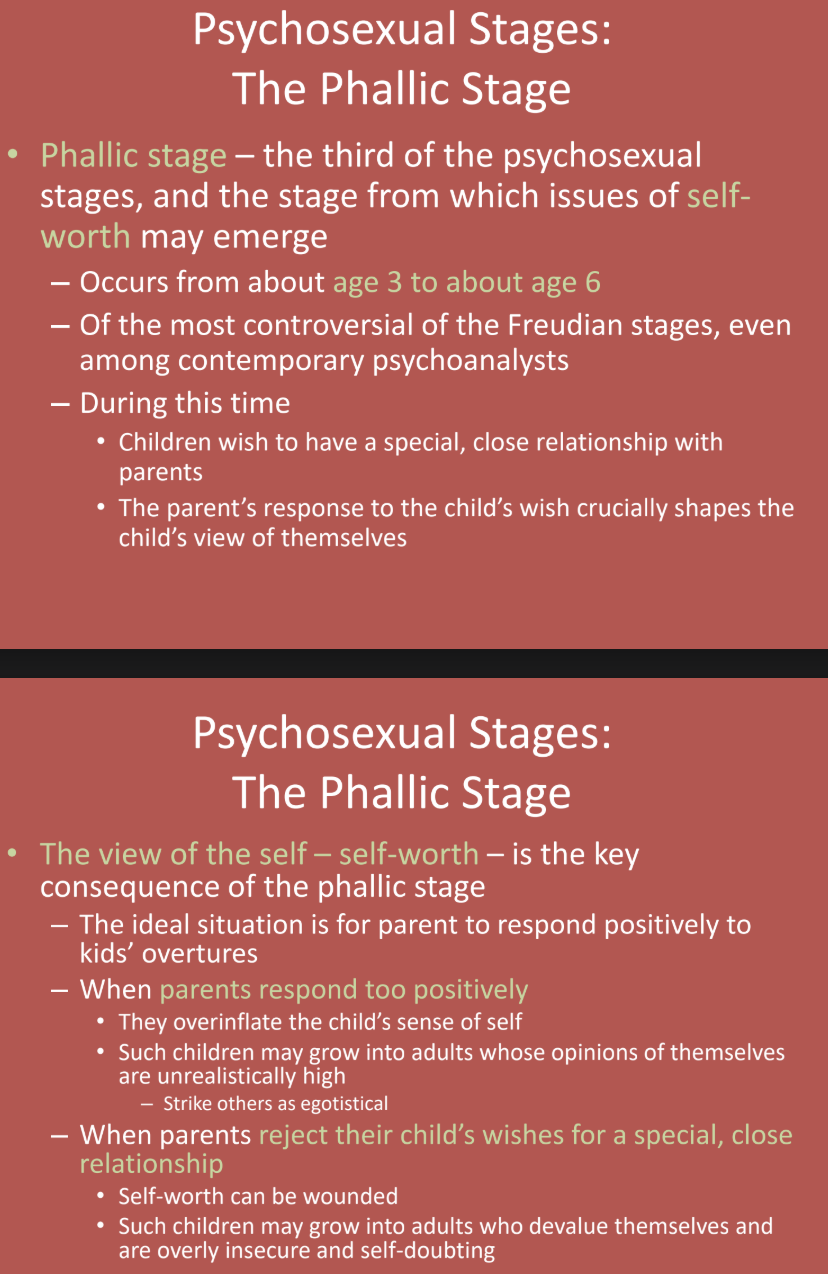
What is the key consequence of the phallic stage? (Psychosexual Stages: The Phallic Stage)
The key consequence of the phallic stage is the development of the view of the self or self-worth.
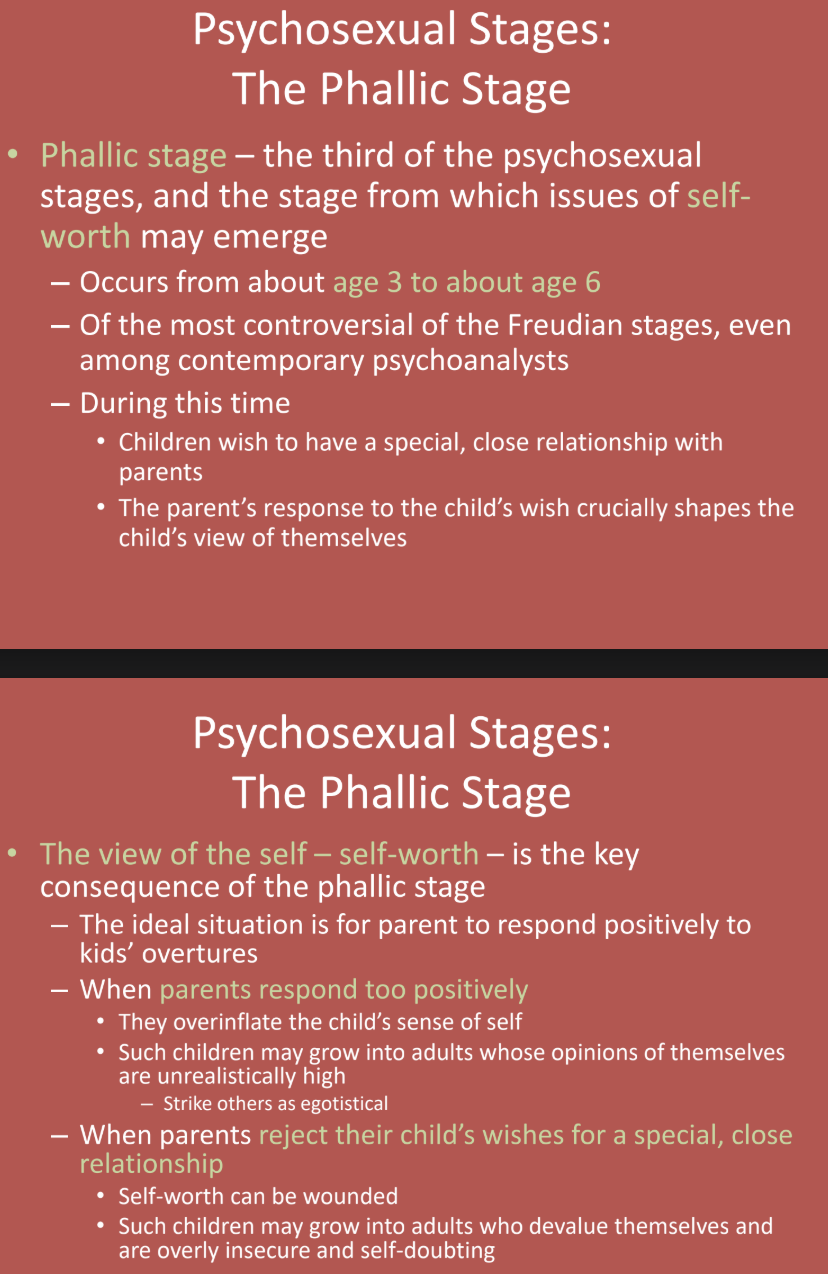
What happens if parents respond too positively in the phallic stage? (Psychosexual Stages: The Phallic Stage)
If parents respond too positively, they overinflate the child’s sense of self, leading to children who may grow into adults with unrealistically high opinions of themselves, often appearing egotistical.
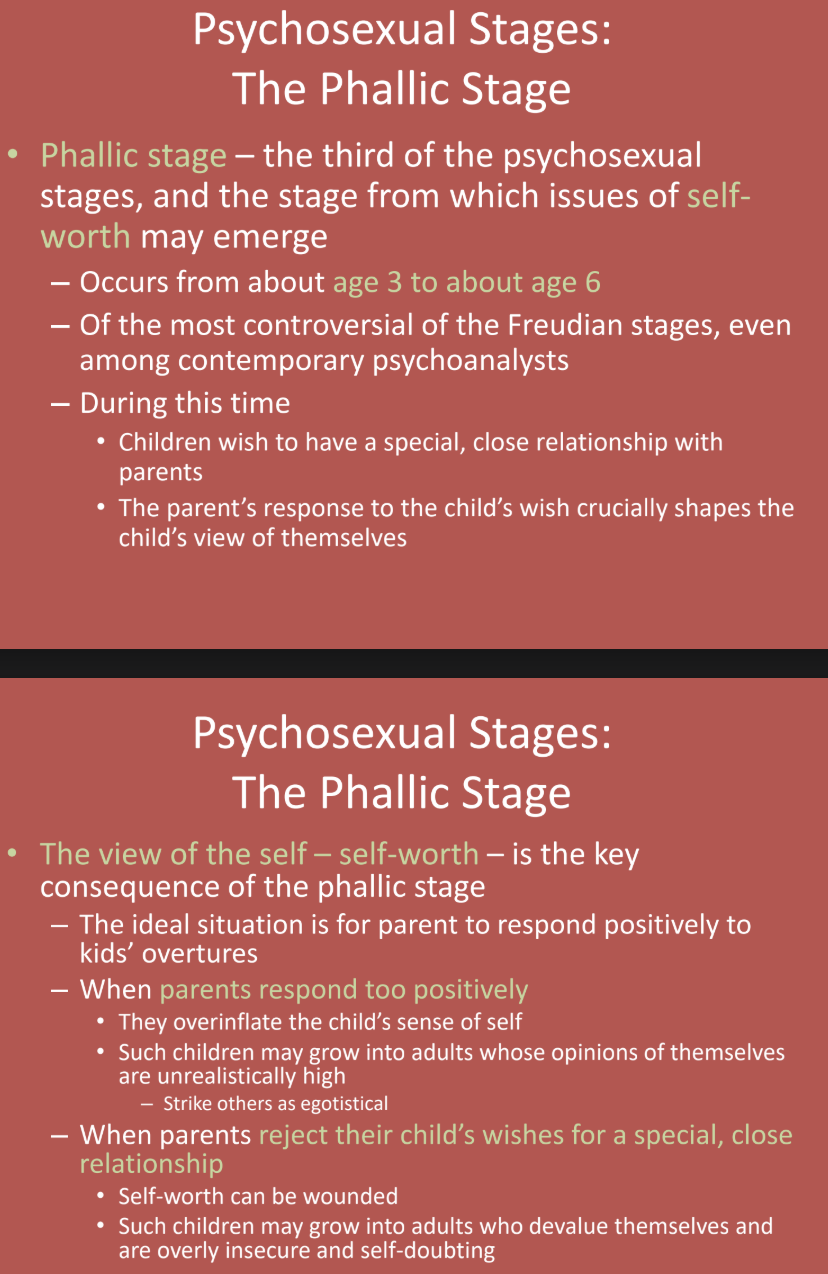
What happens if parents reject their child’s wishes for a special, close relationship during the phallic stage? (Psychosexual Stages: The Phallic Stage)
If parents reject their child’s wishes, the child’s self-worth can be wounded, leading to adults who devalue themselves and are overly insecure and self-doubting.
